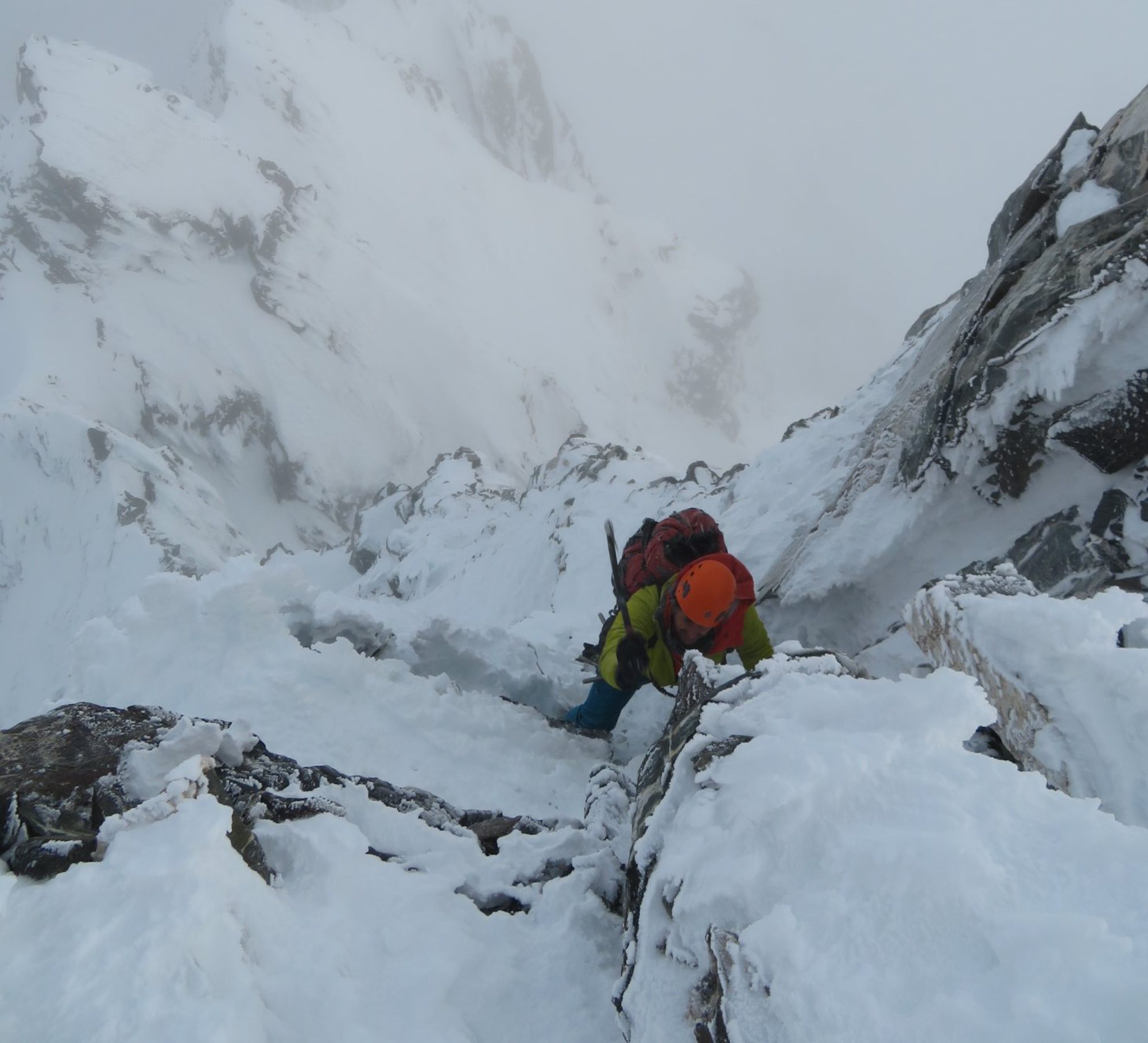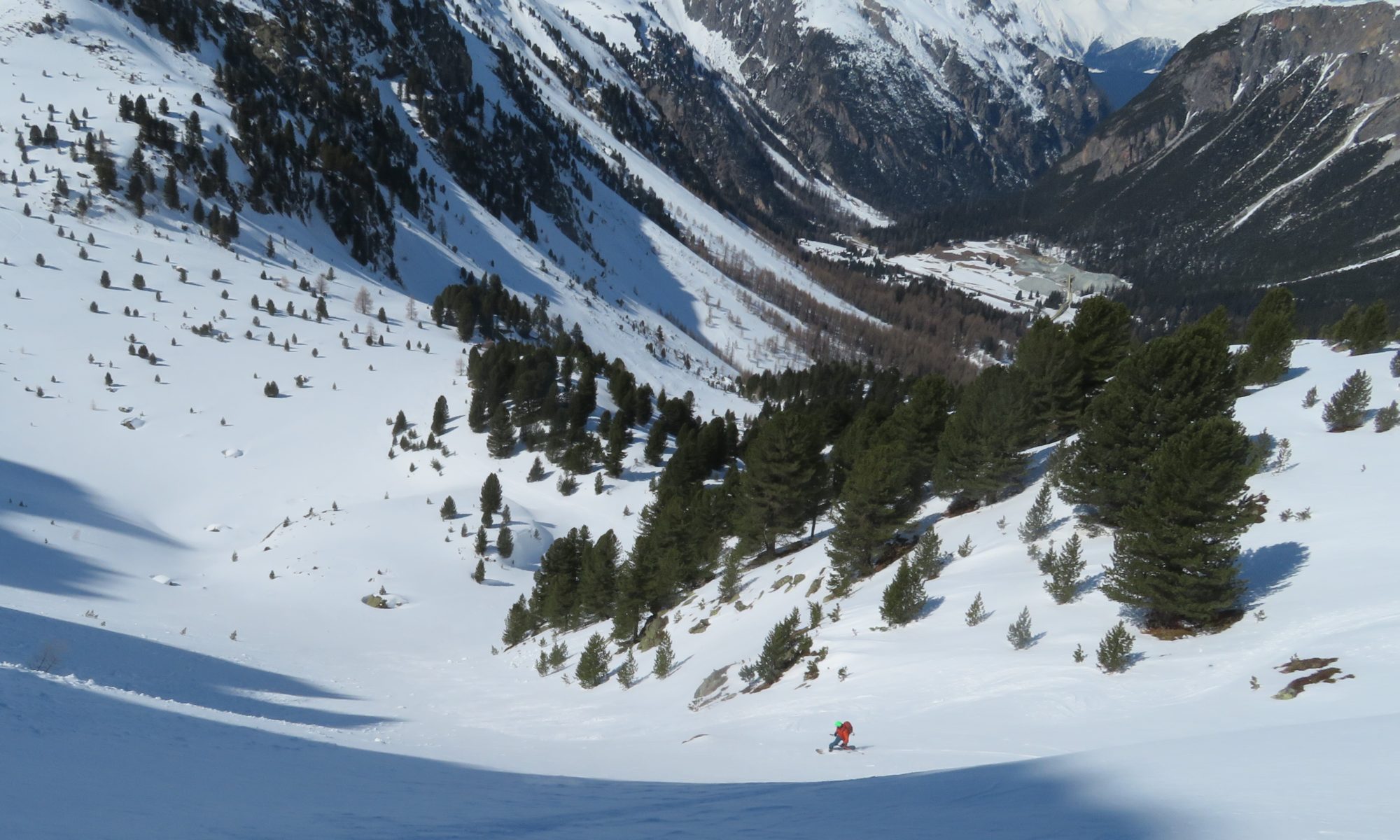Making the best of a bad situation during the rapid escalation of the COVID-19 crisis.
The notion of ascending a mountain using your own power, then descending on skis, sounds like an incredibly fun way to enjoy the Alps. This trip confirmed for me that it is indeed the best way up, and down.
I had been planning this journey for 8 months. I arrived in Zurich on the 6th of March, 2020, with the intention of spending a month in Europe, namely Switzerland, Germany and Austria. My goal was to do as much ski touring in the Alps as possible. Having done years of resort skiing and a few mountaineering trips, I’ve always been fascinated with ski touring and ski mountaineering. Having never skied in Europe before, I was keen to develop these skills in the most highly developed and skier-friendly alpine nations in the world.
Acknowledging the risks of travelling in the mountains in winter (namely the avalanche hazards) I decided to begin my time in Europe with an instructional course, to update and refresh my avalanche safety awareness and general ski touring knowledge. This was well worth the money, and put me in a good place for a subsequent week of touring in the Albula Alps.
My trip was interrupted by the COVID-19 crisis and the closure of the borders with Germany and Austria. I was forced to hurry back to Australia when it became clear that this was the only sensible option. I write this blog from my apartment in Brisbane where I’m completing my compulsory 14 days of self isolation for all travellers returning from overseas. I feel incredibly grateful that I was at least able to do 2 weeks of quality ski touring before my trip was cut short, and want to say a huge THANK YOU to all who helped me out in getting me back home safely!
Part 1 – Advanced Ski Touring course with the International School of Mountaineering (ISM)
I began my journey by joining a week-long course run by ISM – a British mountain guiding outfit – which ran out of the Swiss ski town of Leysin. The course was excellent value for money, and worth it just to meet some great skiers from around the world. We did two day-tours from our hotel in Leysin, before heading high into the hills above Leukerbad to do three days of hut-based touring from Lämmeren hut. All of this whilst receiving quality information and coaching from our expert guide Terry Ralphs – covering avalanche safety, snow science, route selection and off-piste ski technique.
Day 1 – Tête à Josué (2133 m)
Our first day of the course on Monday March 9th we awoke to ~15cm fresh snowfall, which had followed a long period of dry weather. The Swiss avalanche forecasting service SLF recommended that the avalanche risk was considerable in our area. The fresh snow on top of a mostly consolidated base meant that natural avalanches could be expected, so we chose a ski tour that largely avoided slopes with angles greater than 30°. This lead us to Tête à Josué, a relatively simple tour with ~1000m of elevation gain, mostly below the tree line but with a final ~200m above in the exposed alpine.
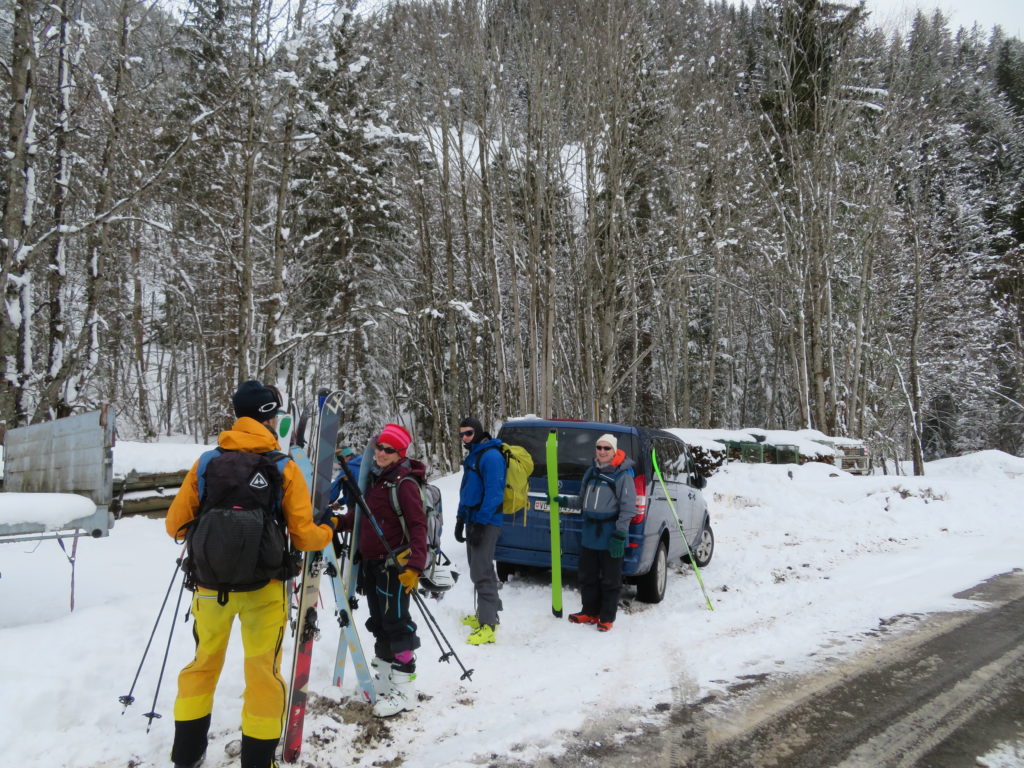
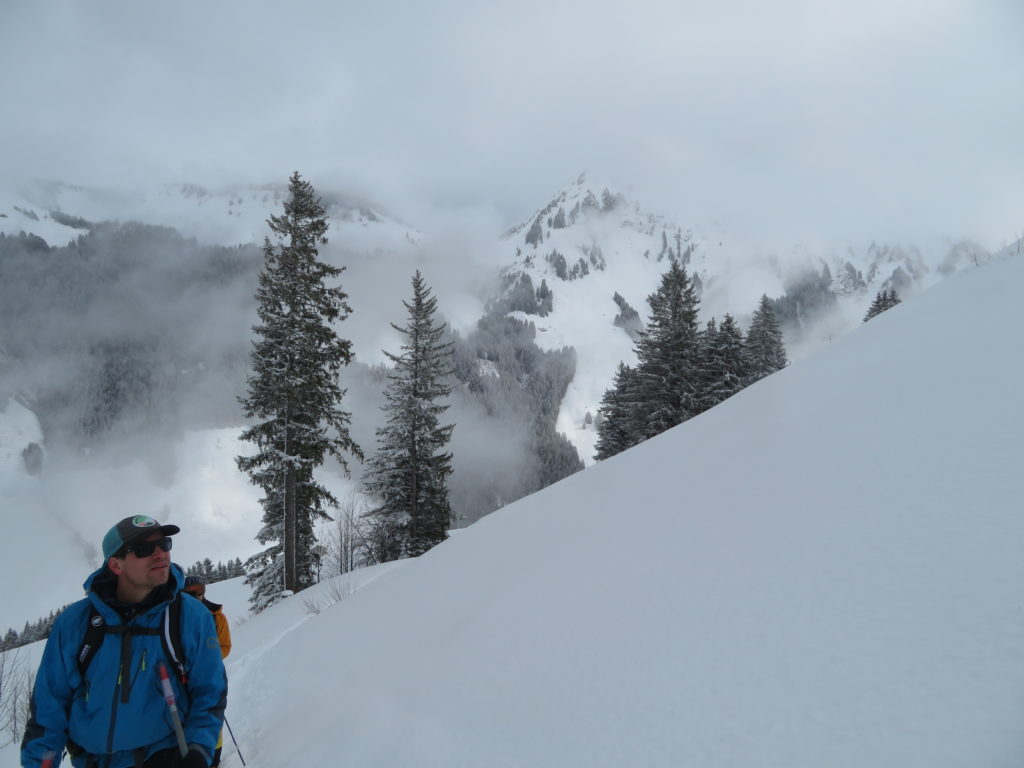
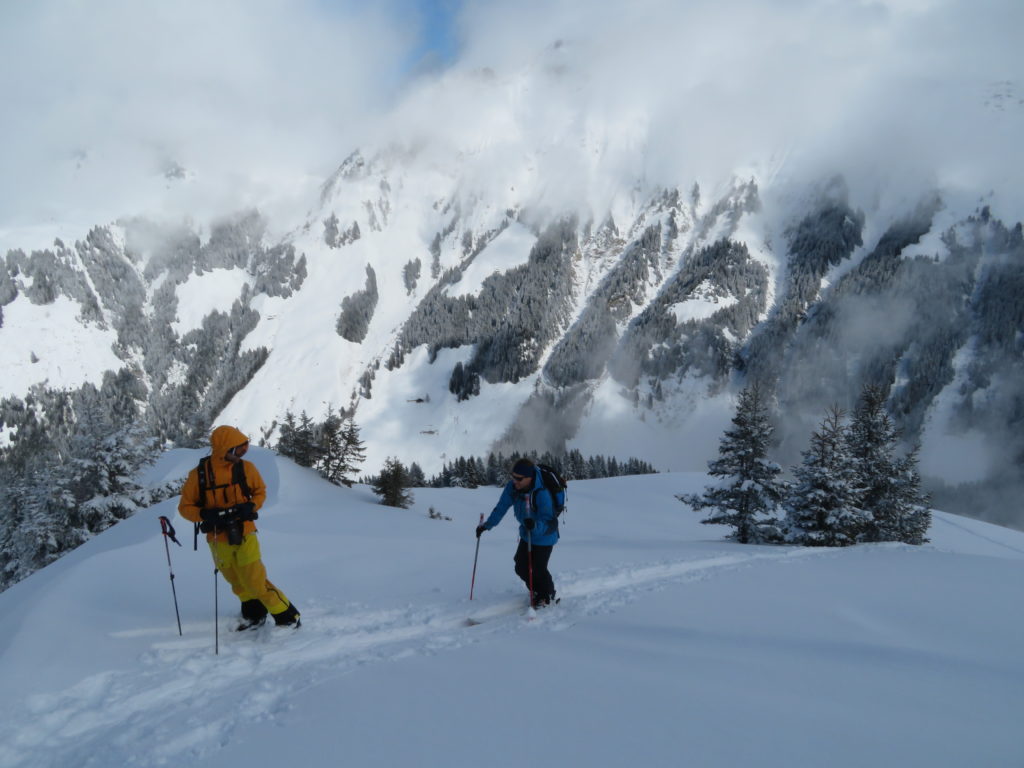
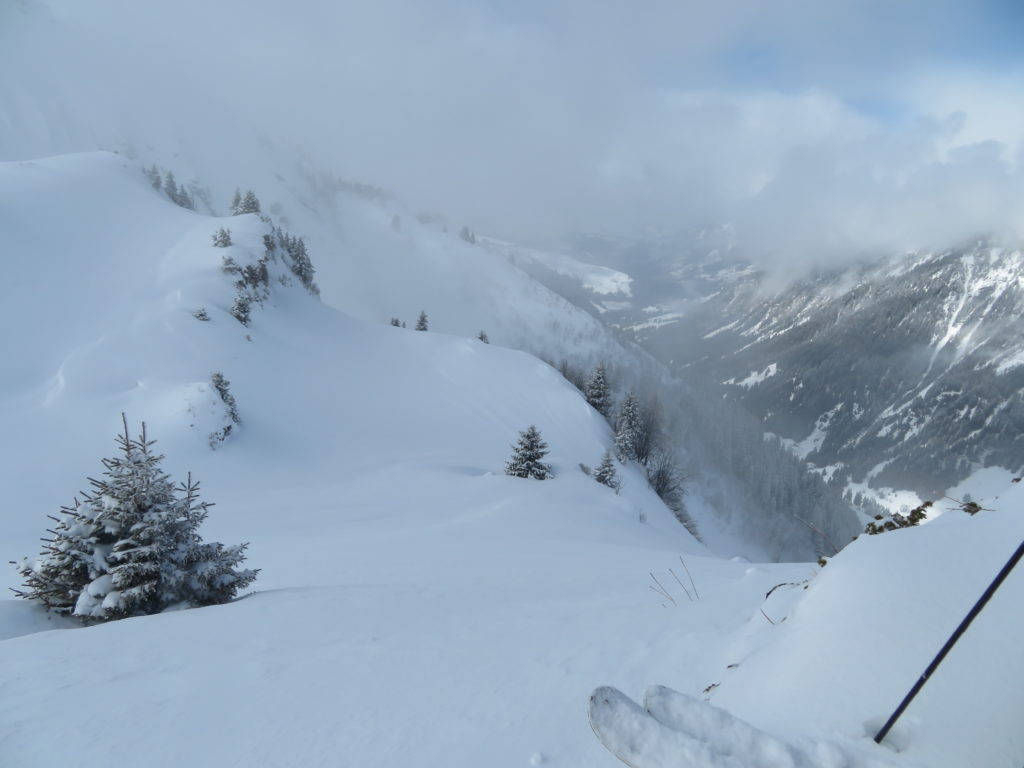
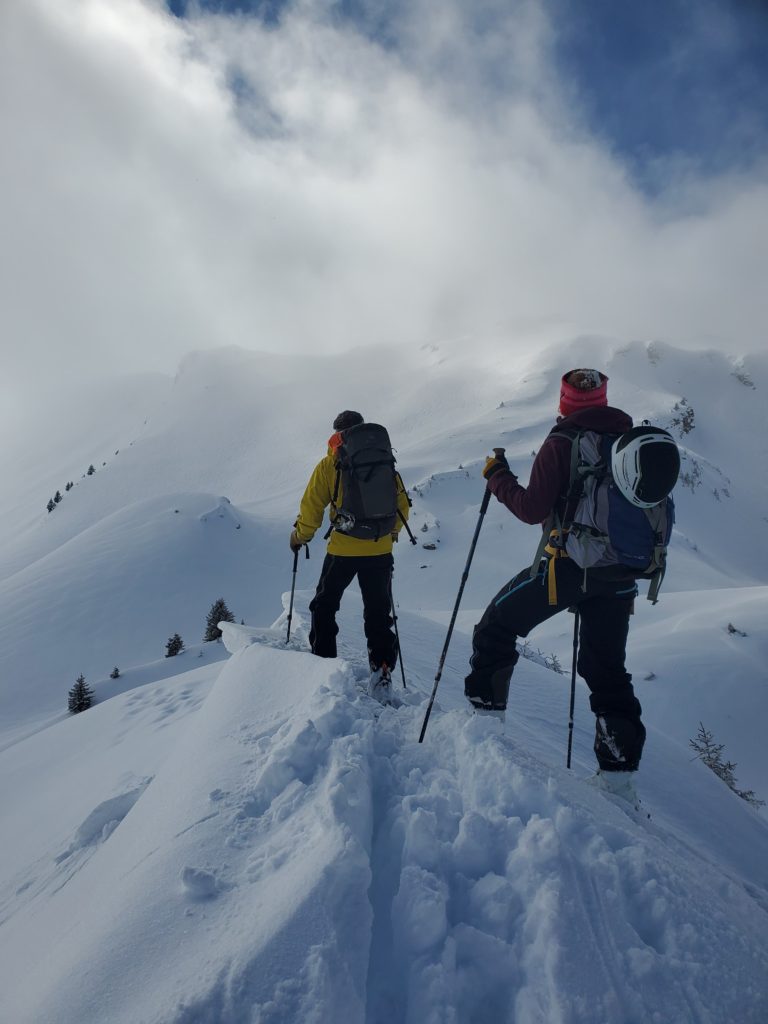
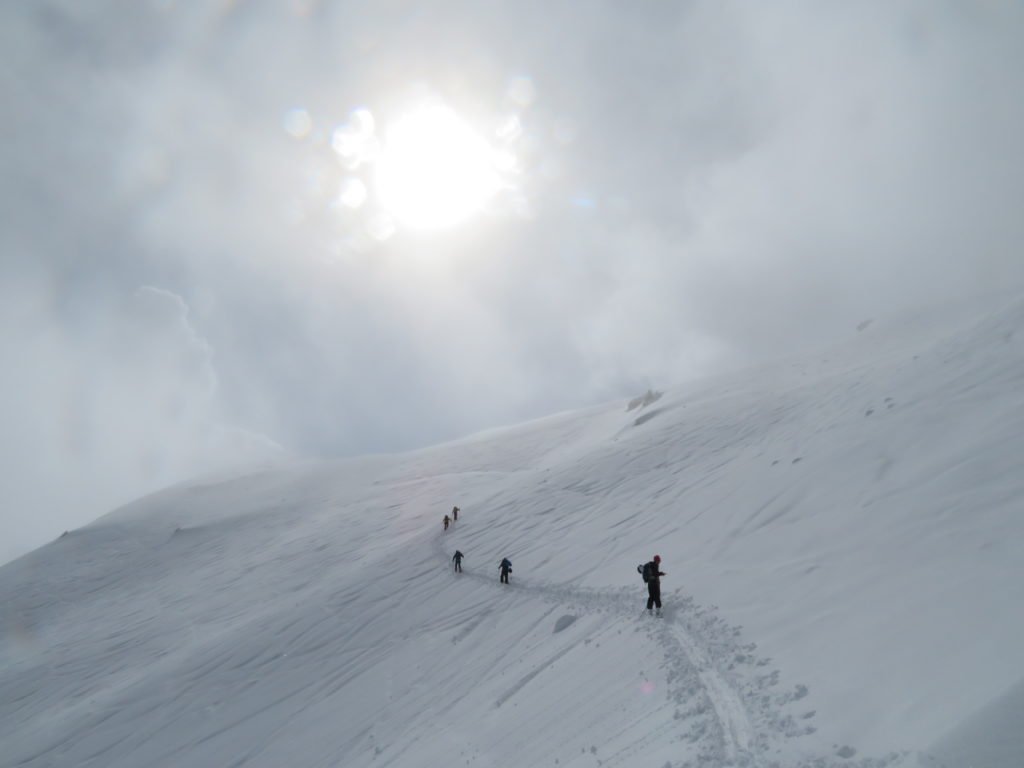
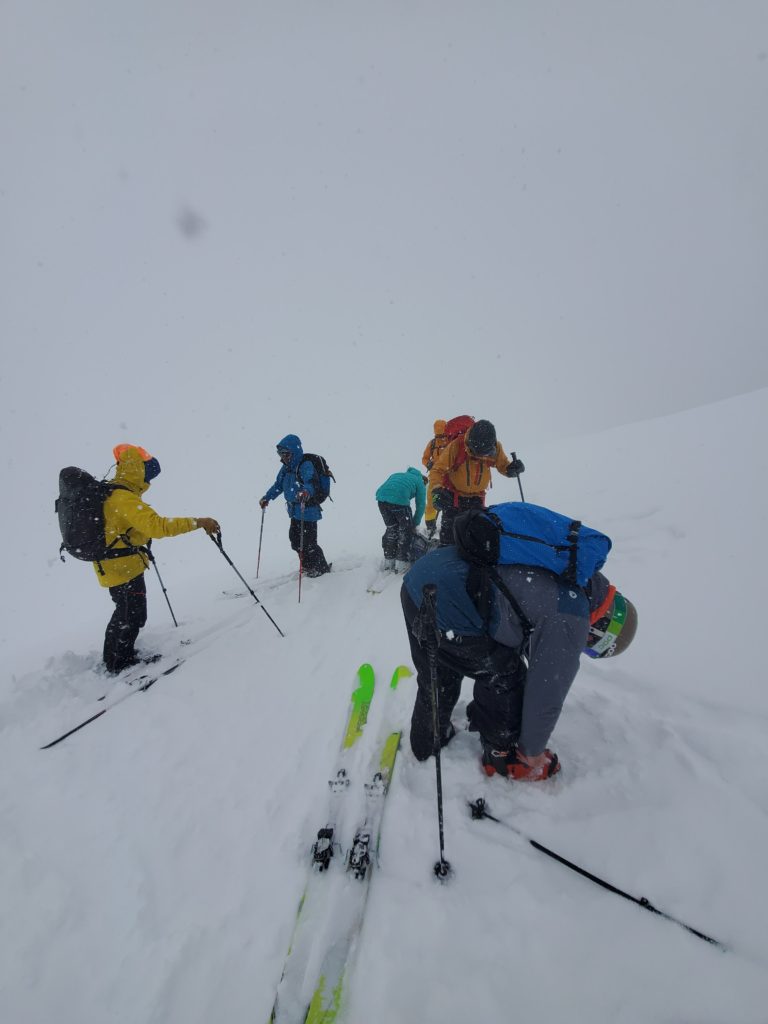
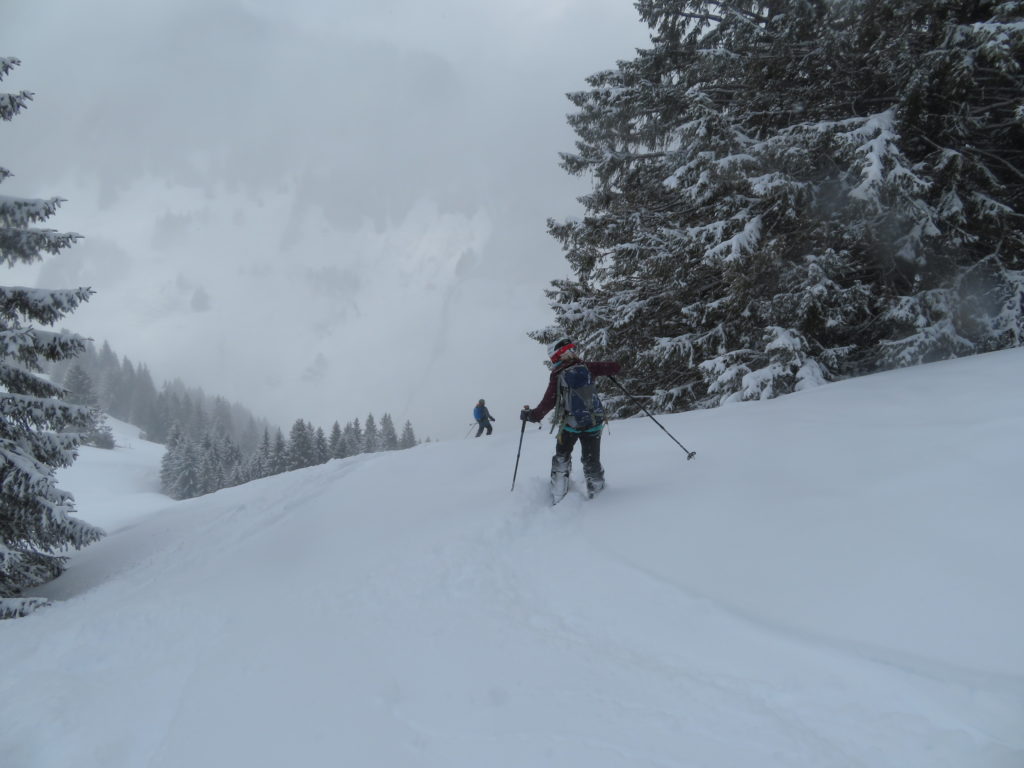
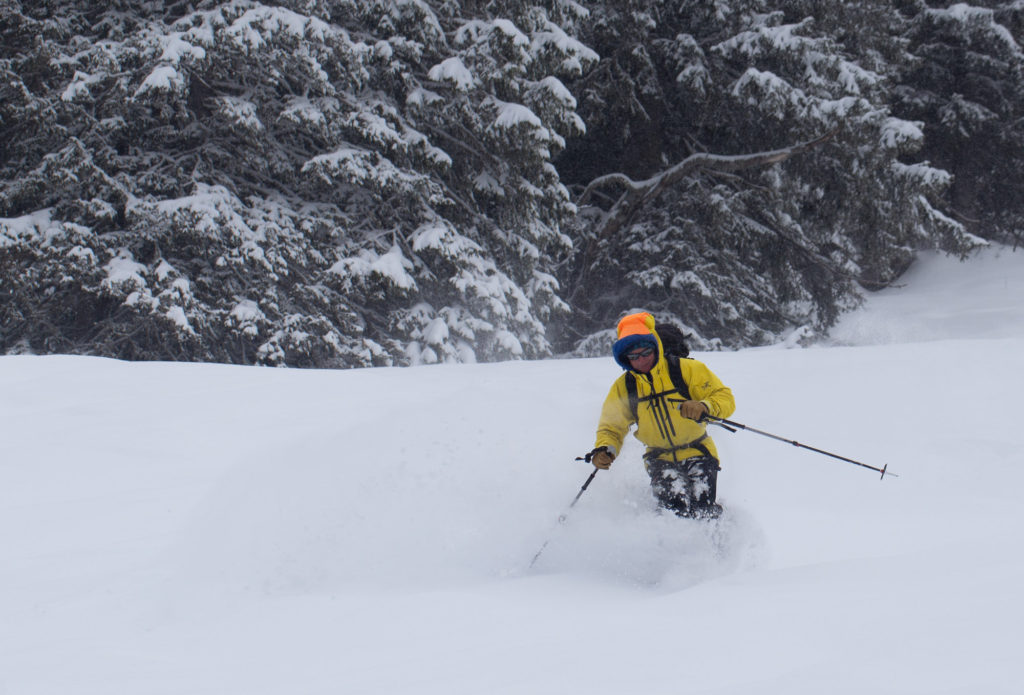
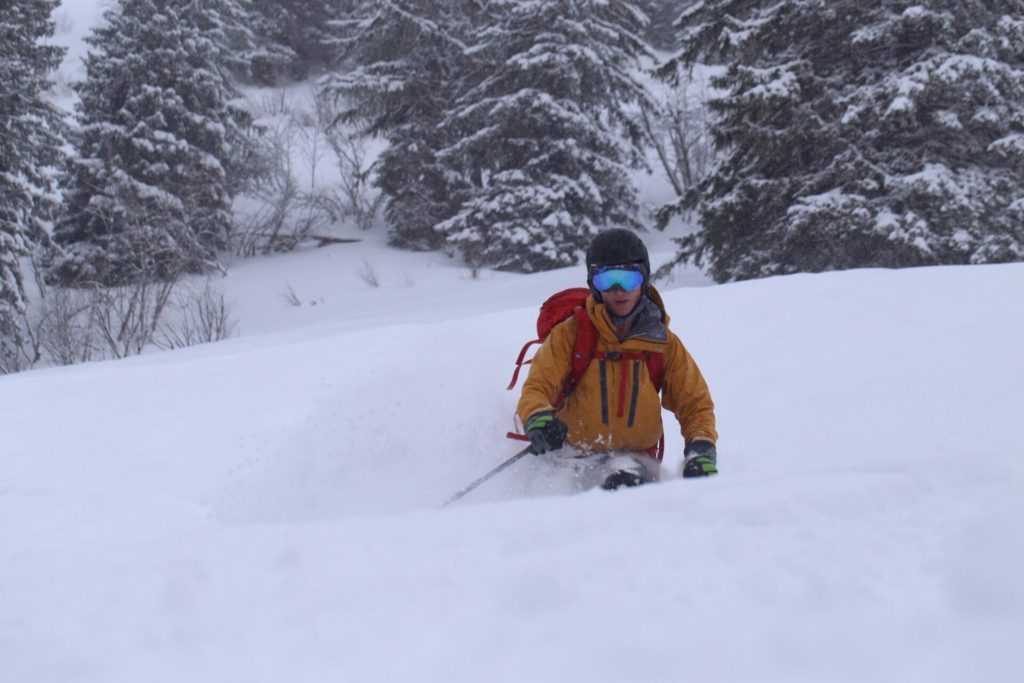
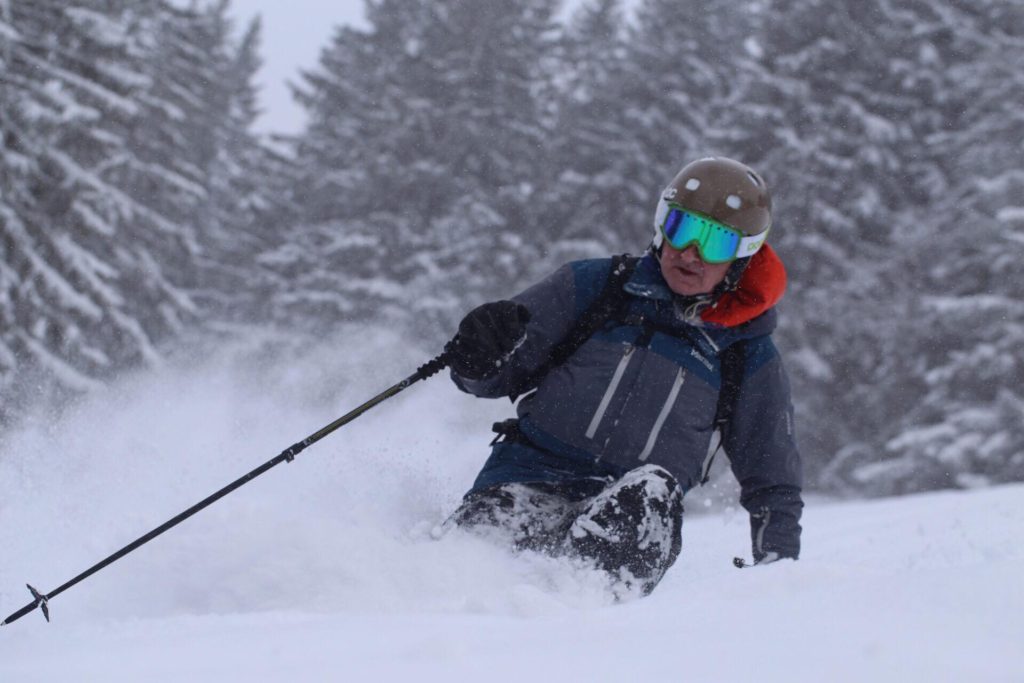
Day 2 – Walighurli (2050 m)
The second day of the course saw further fresh snow and low cloud cover. We decided to do a very mellow and relatively low altitude ascent of Walighurli – given that the avalanche hazard was still considerable, and the visibility was likely to be poor once we were above the treeline. Beginning in Gsteig, the ascent of ~900m up the south east ridge to the summit was relatively simple and low angle, however we were still exposed to strong winds and had to be careful when traversing above some steeper slopes.
Arriving at the summit after ~3 hours, the wind and low visibility was uncomfortable, however the temperature was relatively warm and above 0°C. We descended the North side of the mountain towards the village of Feutersoey. We enjoyed some excellent powder on the first half of the descent, before the snow started becoming wet and sticky on the bottom half of the mountain. With temperatures getting as high as +10°C, the fresh snow was fast melting and becoming difficult to ski. From Feutersoey, a short bus ride returned us back to Gsteig where we parked the car – Switzerland amazes me in how easy it is to get from one location in the mountains to another utilising public transport!

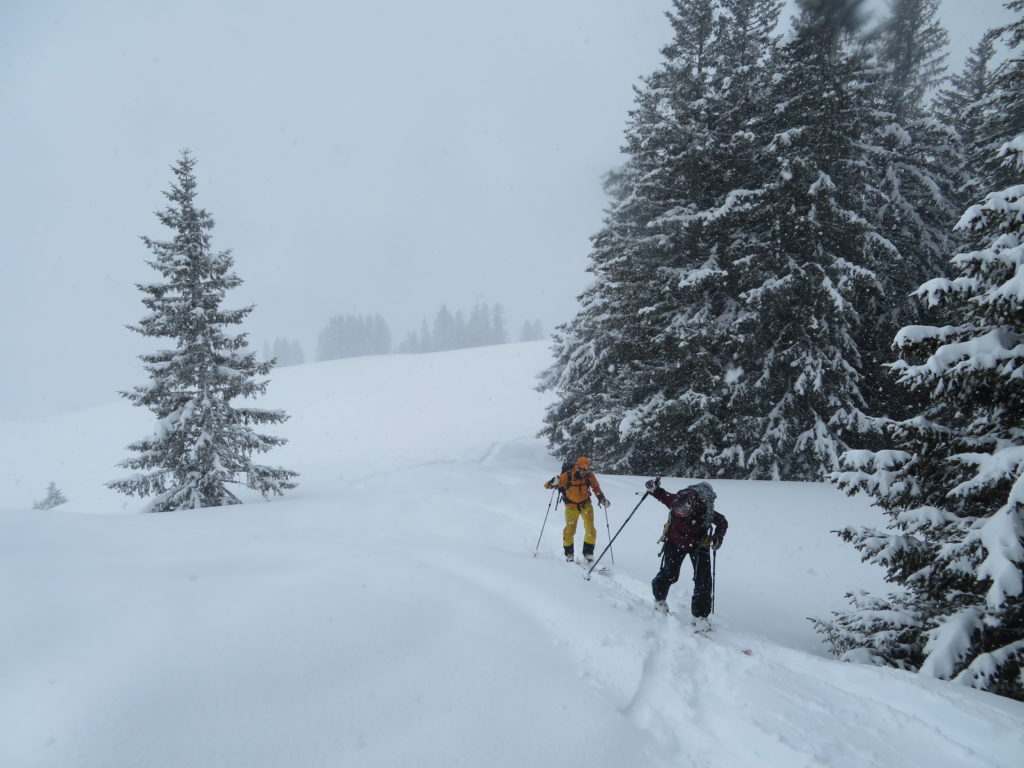

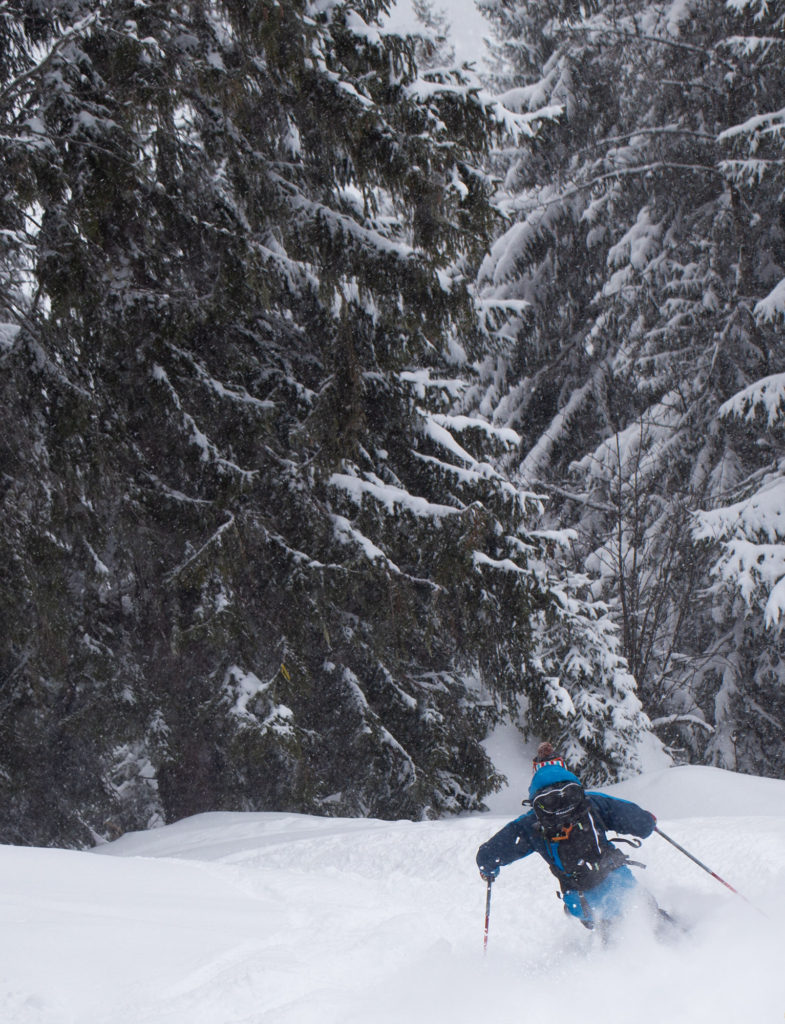
Day 3 – Gemmi Pass to Lämmeren Hut (2502 m)
With a few days of mostly clear weather forecast, our guide Terry decided to drive us to Leukerbad where we could catch a cable car up to Gemmi Pass. From there a short ~2 hour traverse along mostly flat terrain brought us to Lämmeren Hut where we would spend 2 nights. Despite little new snow and perfect blue bird visibility, the avalanche risk was considerable, with wet slides occurring all around us. The temperature was very warm at ~10°C in the full sun, which was causing the snow pack to become more loose and unstable.
On reaching the hut (aka – alpine hotel with hot showers, beer on tap and a kitchen serving three course meals…), we decided the avalanche conditions were too dangerous to allow for a safe ascent of any of the surrounding peaks. We instead used the afternoon to practice crevasse rescue and discuss the plan for the next day. The alpine environment we had arrived at was absolutely stunning, with a large number of potential objectives possible from Lämmeren Hut. However, extreme vigilance was required to stay safe given the high objective hazard of the avalanche terrain and potential for hidden crevasses on the nearby glaciers.
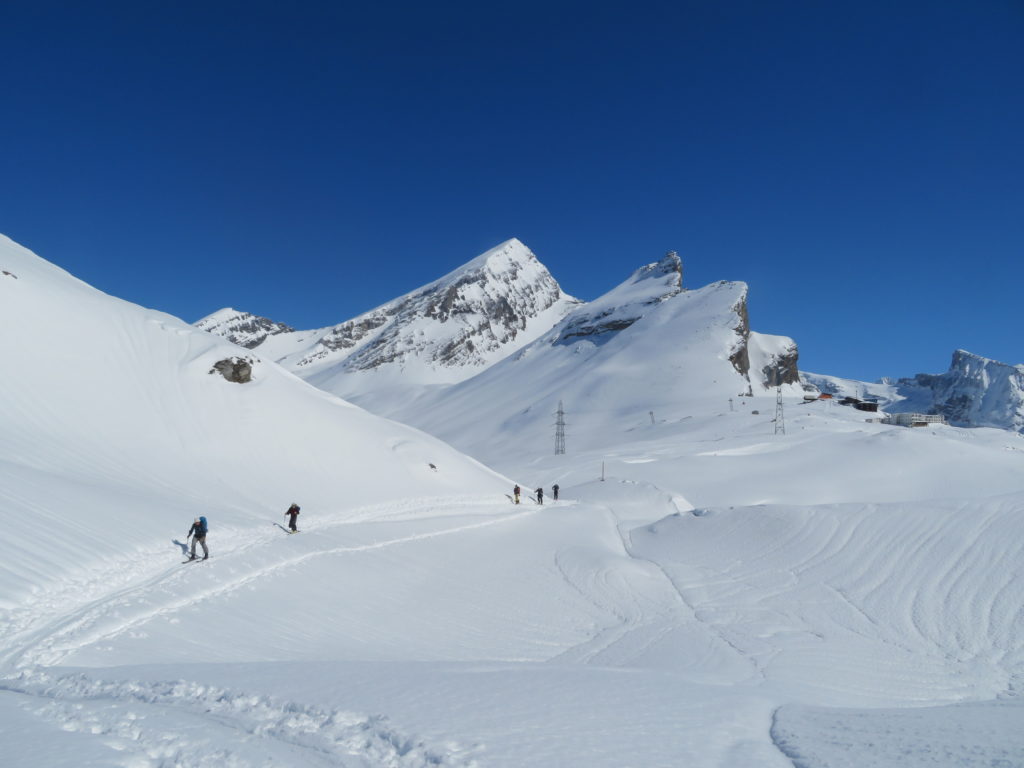
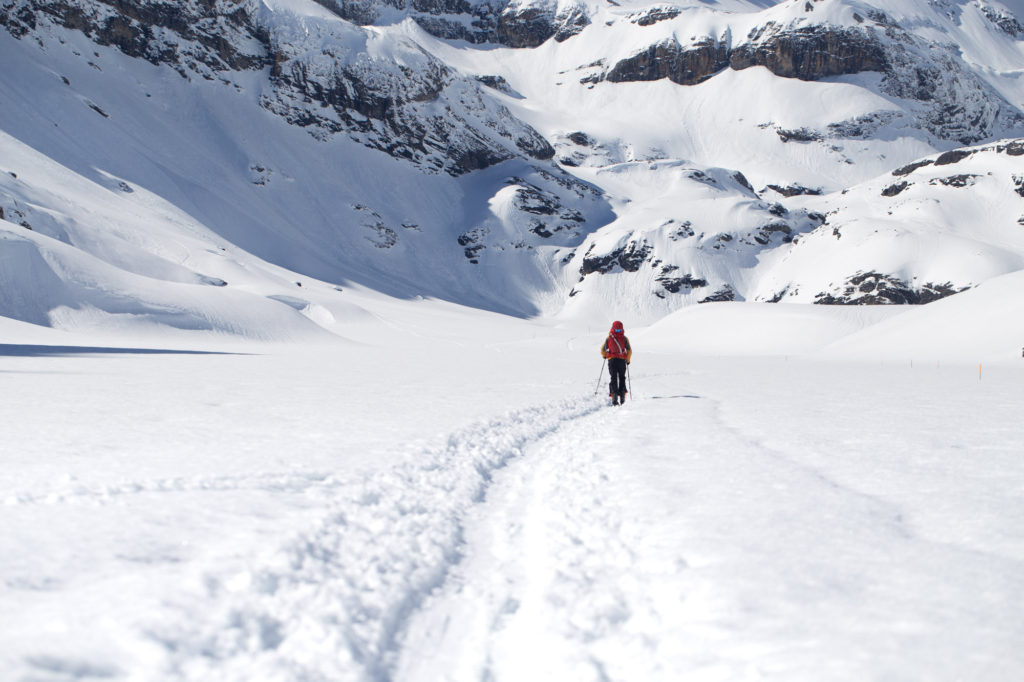
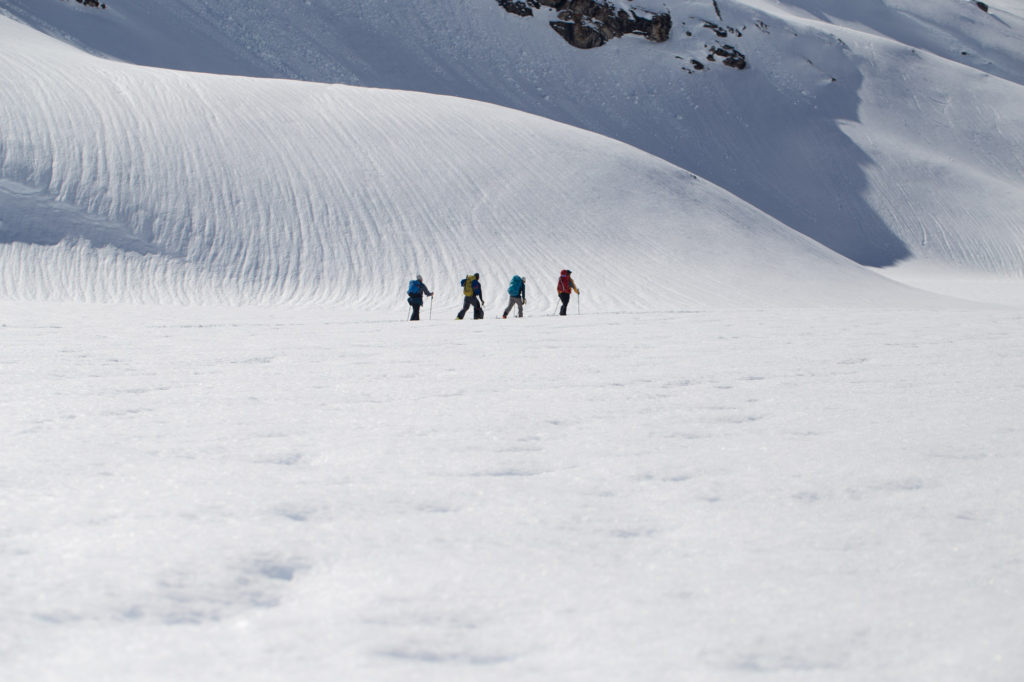
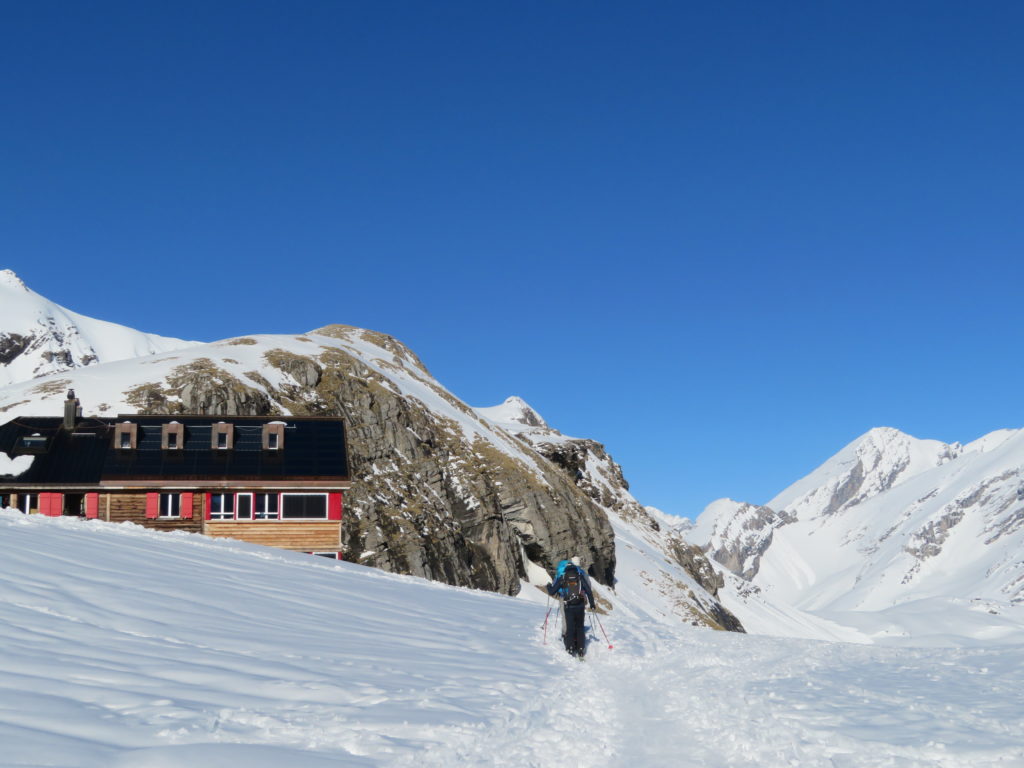
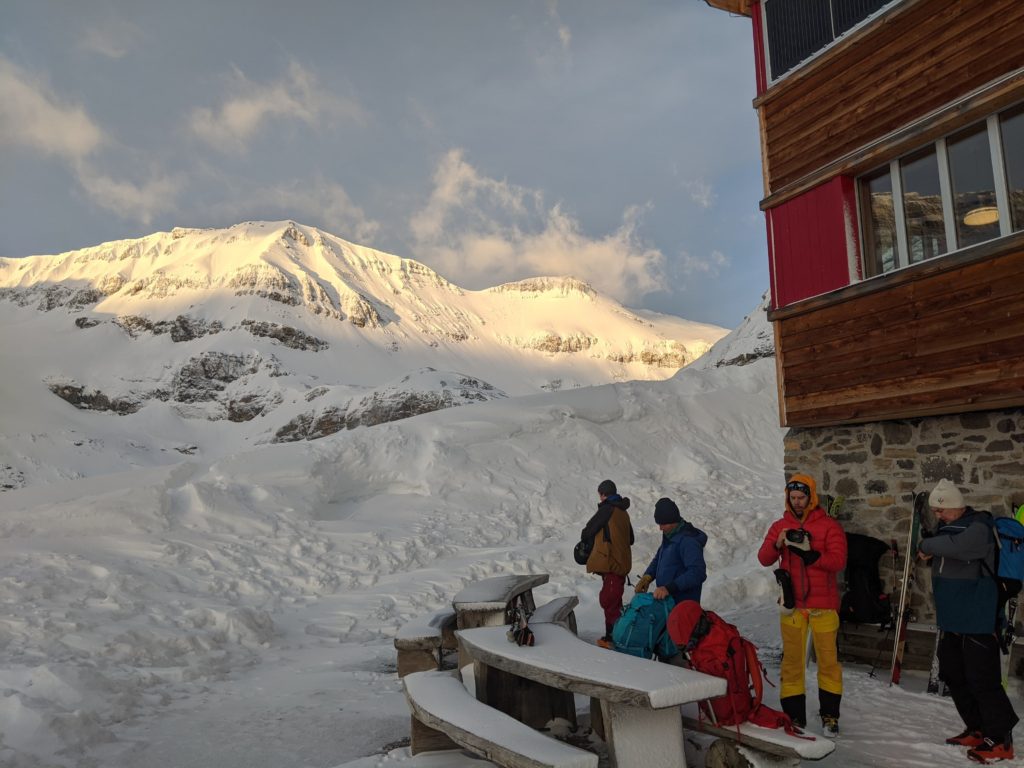
Day 4 – Schwarzhorn (3104 m)
Awaking at 6:30 am to enjoy a hearty Swiss breakfast and grab a litre of hot tea for our drink bottles, we left Lämmeren hut at 7:15 am for our objective of Schwarzhorn via the northwest face. With a good overnight freeze due to the clear sky, the snow was firm and solid, offering relative safety from avalanches in the morning. We were aware however that the heat of the afternoon would cause things to deteriorate and wet slides would likely become a problem, so we aimed to summit and return to the hut by ~1:00 pm.
The icy conditions under foot made for challenging skinning, especially on the steep terrain >30°. Stepping over a small cornice ~50m below the summit, we could see deep wind scouring that explained why the snow was so icy. The descent was very difficult skiing, with the frozen snow offering little for our edges to bite into. For the first time I found myself having to jump turn: regular on-piste technique simply didn’t work. I was glad to get down without stacking it or getting hurt.
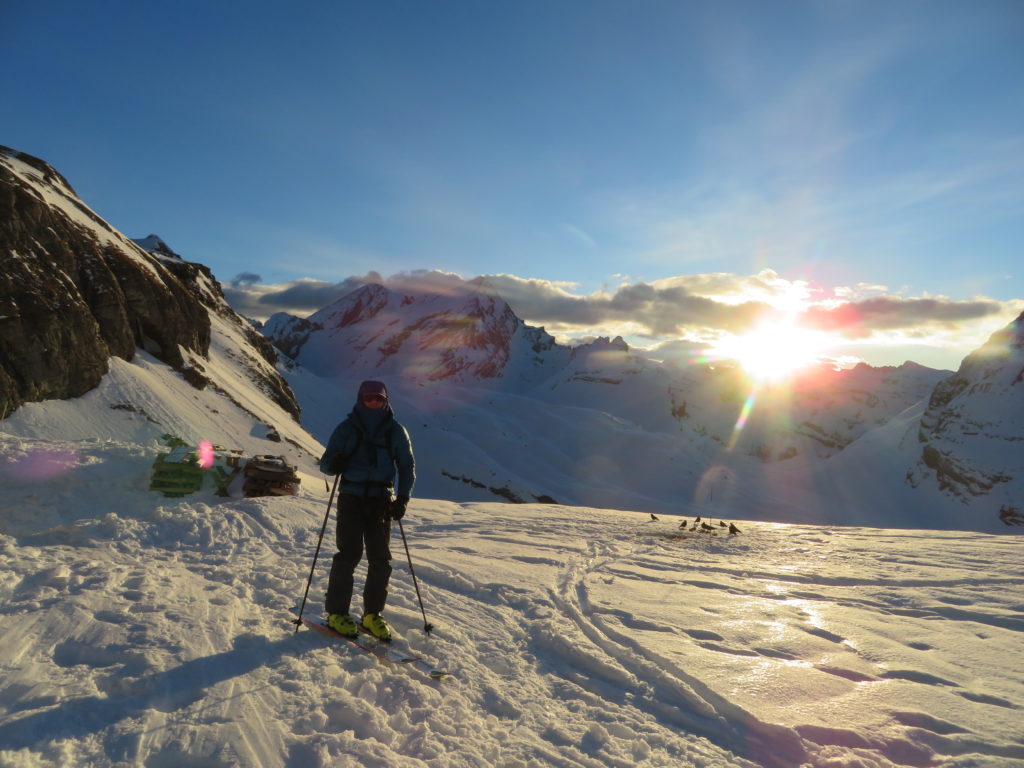


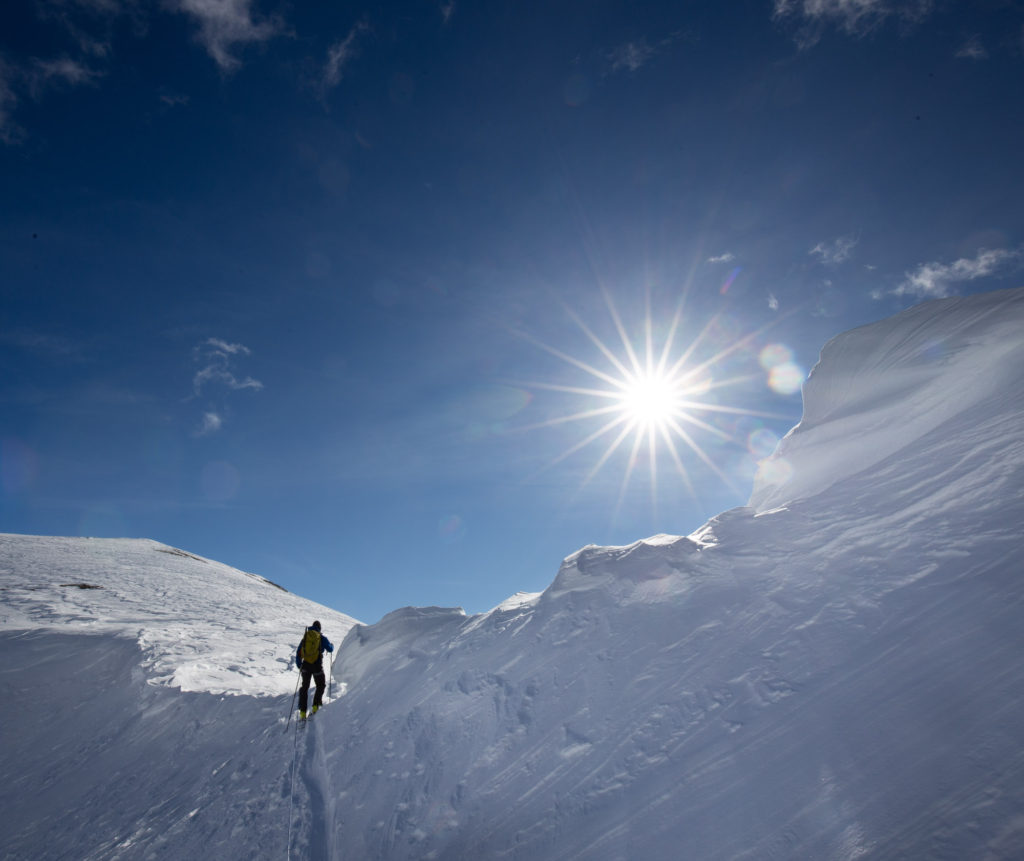
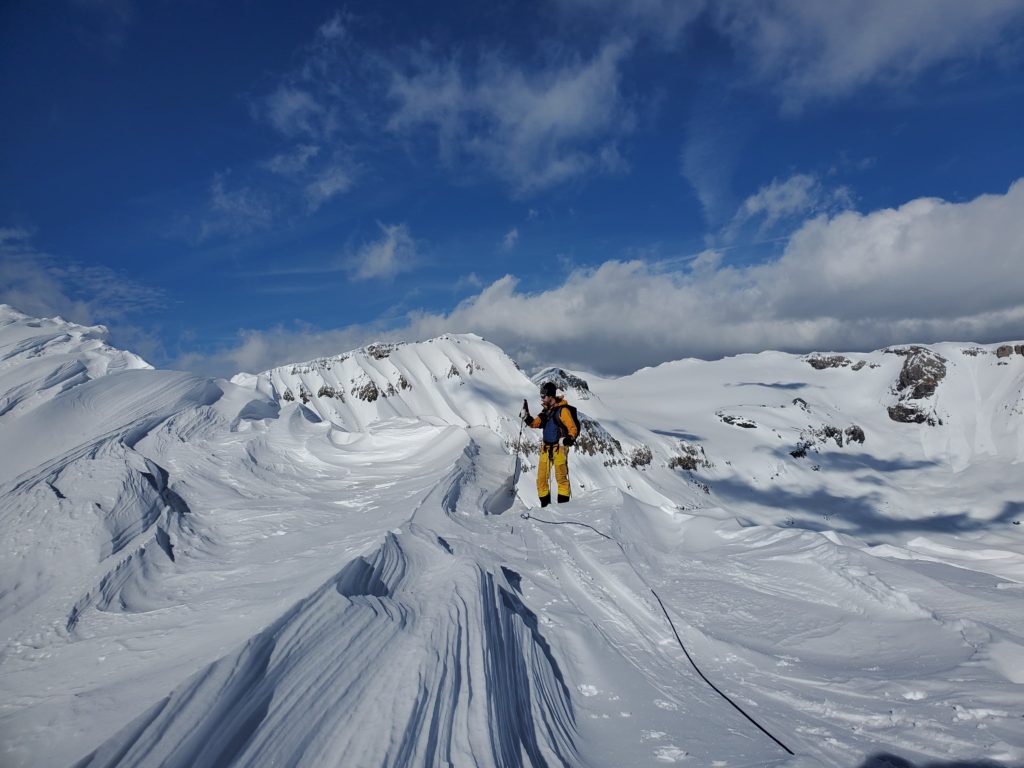
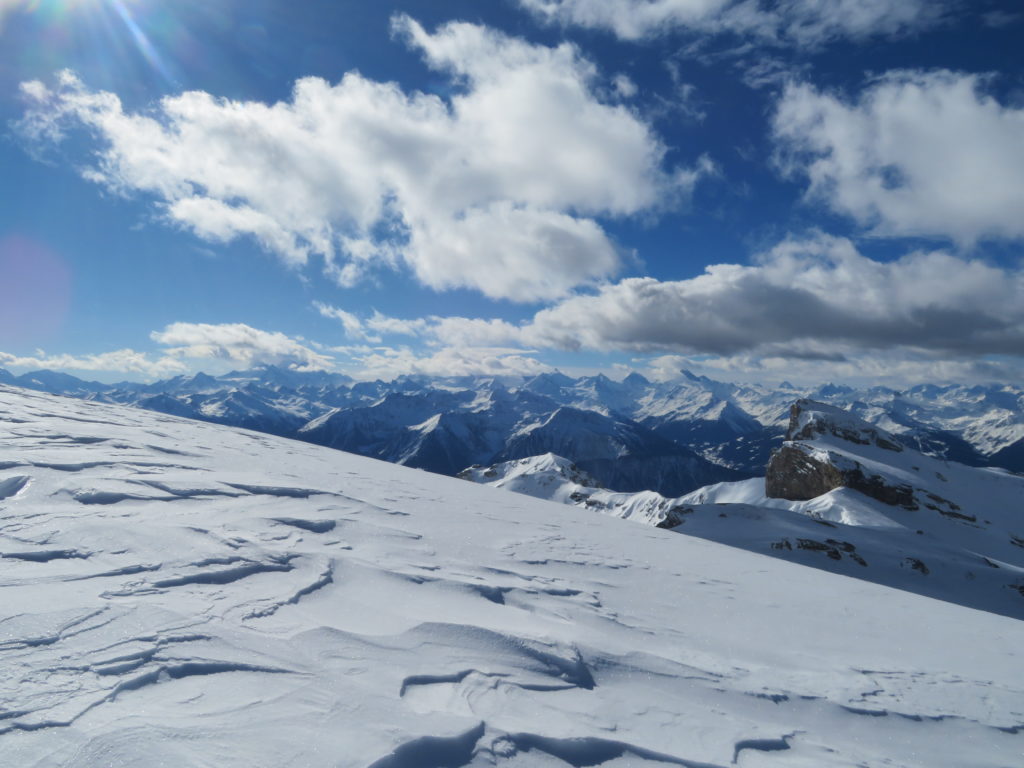

Day 5 – Daubenhorn (2941 m)
Repeating the same routine as the previous day, we awoke to a spectacular sunrise and ~10cm of fresh snow. We ascended the peak of Daubenhorn on our way back towards the cable car at Gemmi Pass. The fresh snow increased the avalanche risk a little, so again we chose a route which stayed clear of slopes great than >30°. After a few hours of uphill effort, we arrived at a protected spot ~100m below the true summit where we stashed our gear and roped up for the final few steps towards the summit.

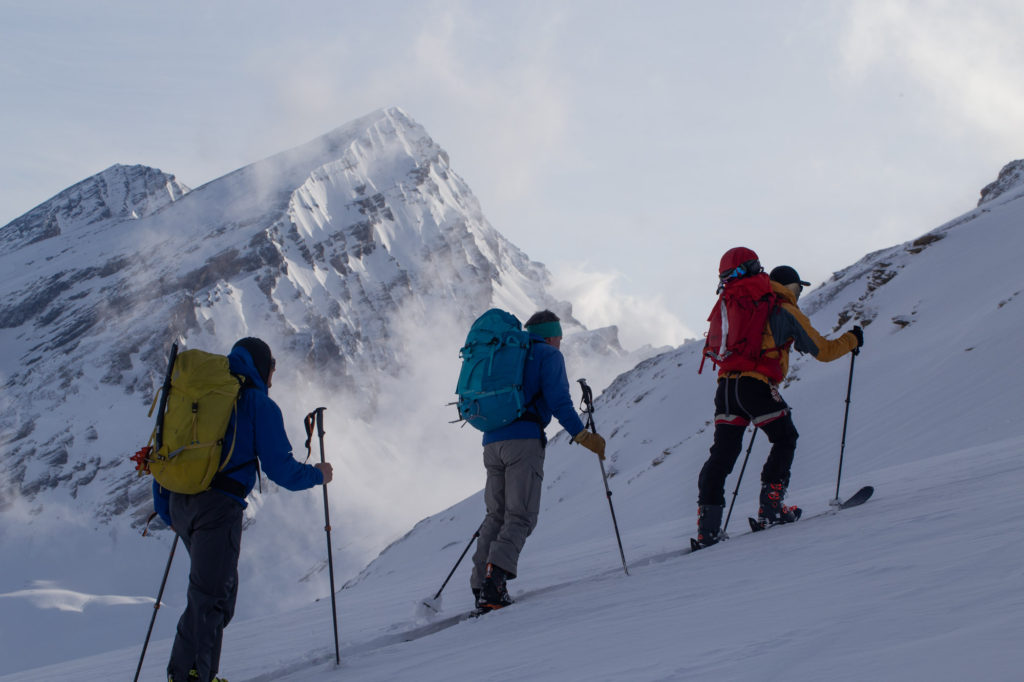
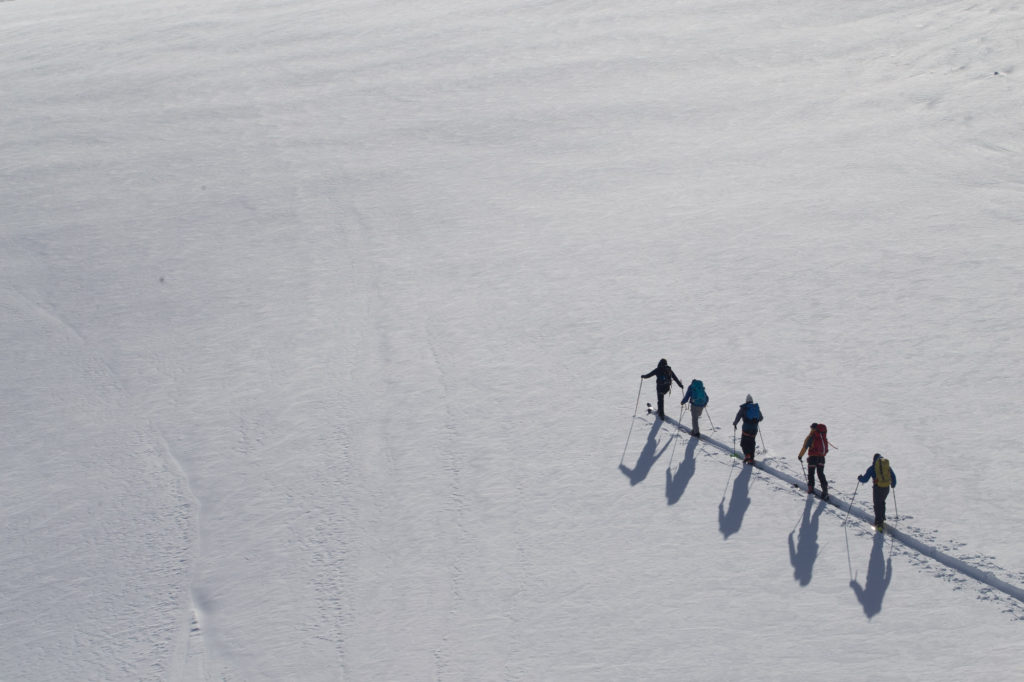
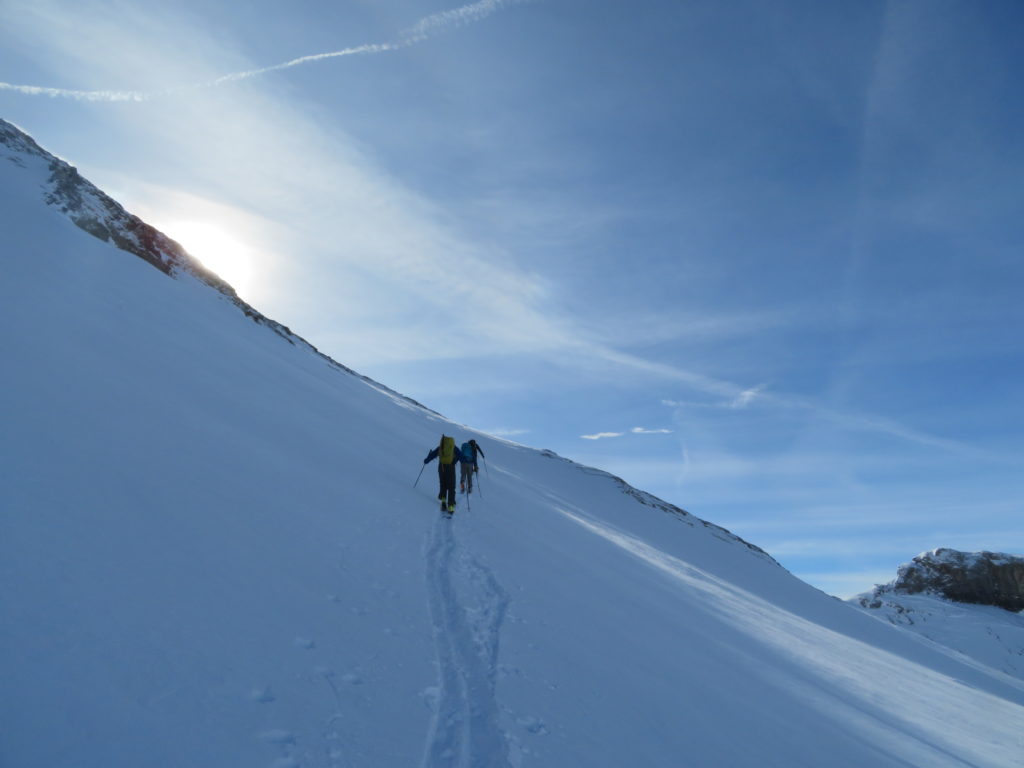
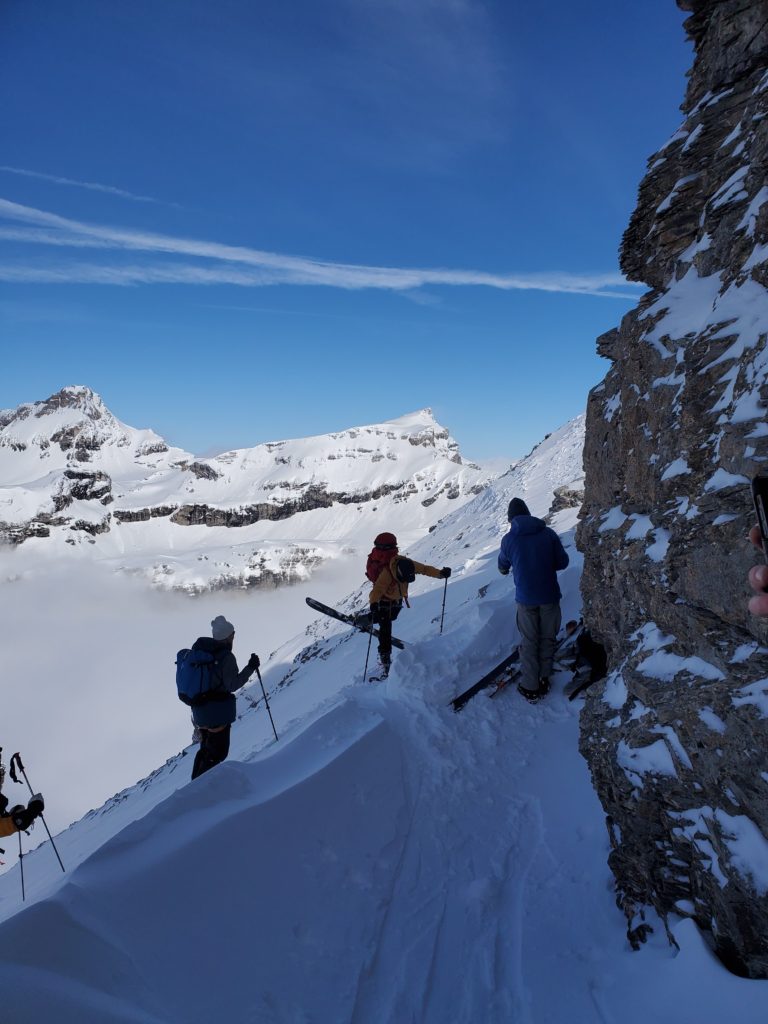
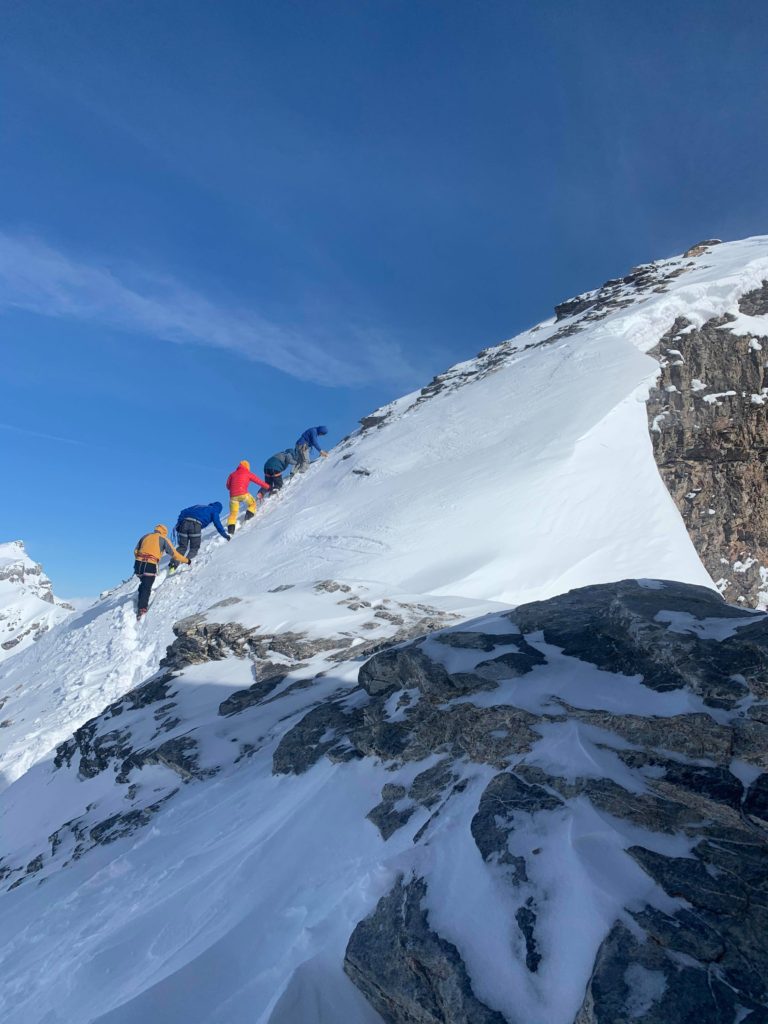
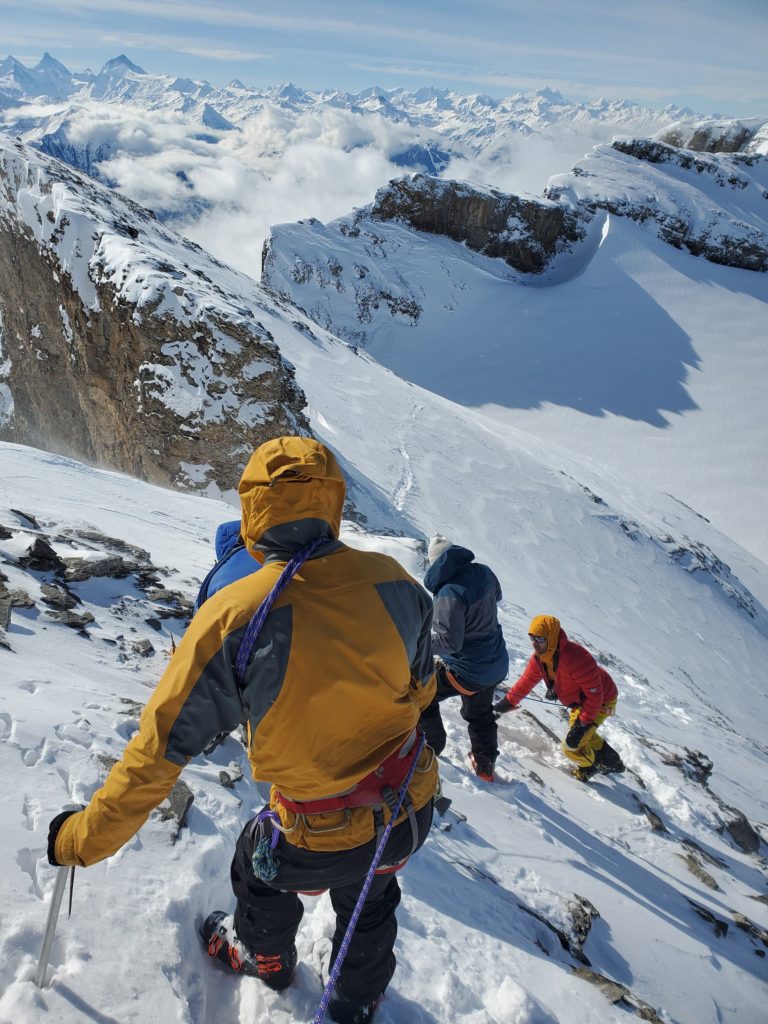
The ski descent of Daubenhorn was outstanding. We had almost unlimited fresh snow, and so we were each able to lay down fresh tracks. Terry showed us the difference between traversing and fall-line skiing – to get the maximum turns in, sometimes you have to traverse high for a while before dropping into the fall-line. This way you avoid the situation where you do a single turn then have to traverse for another section.
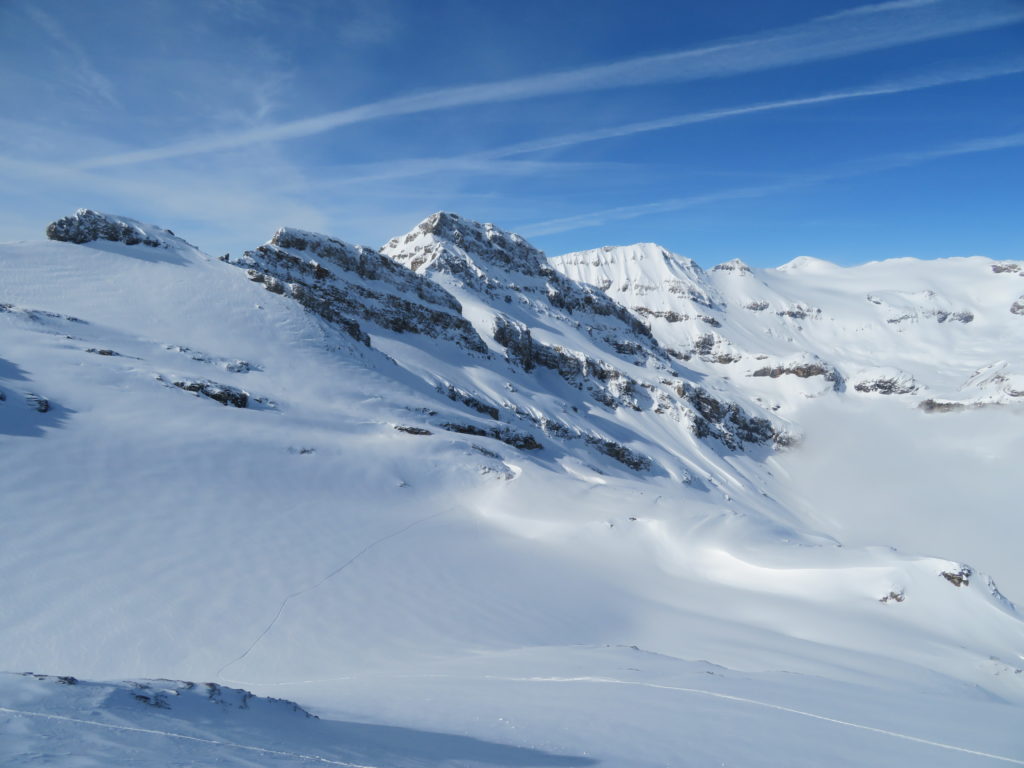
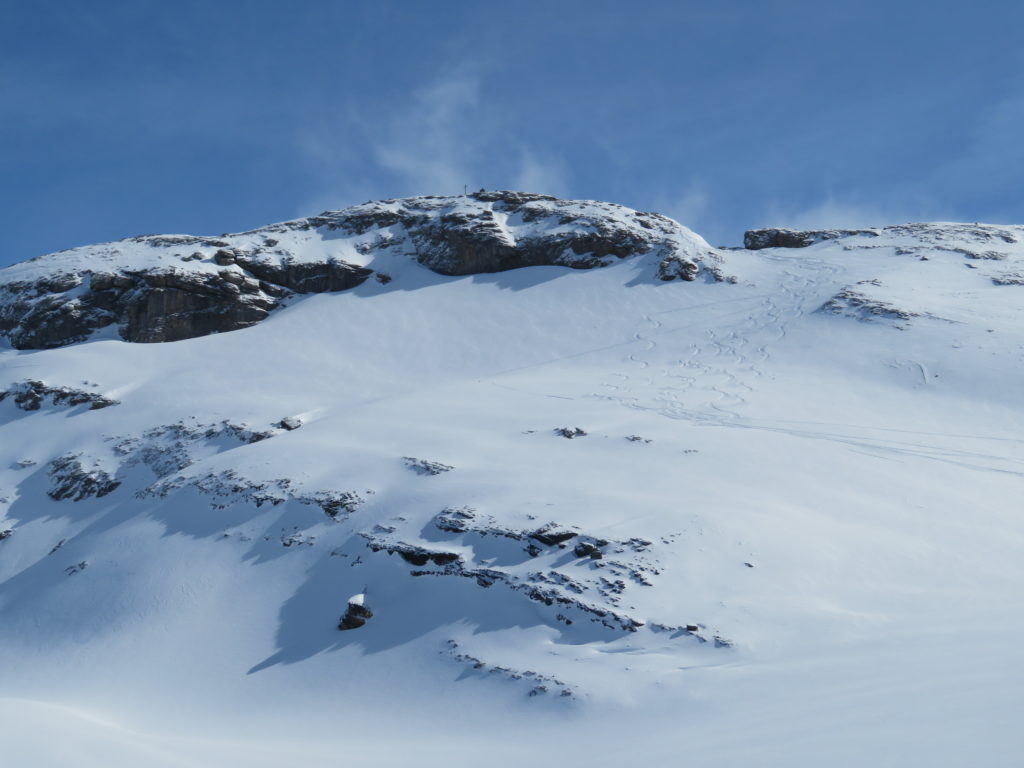

Overall, I feel extremely lucky to have chosen to join this course. The group was strong and great company; I hope to do more ski trips with the people I’ve met. Terry’s instruction was highly practical, sharpened my safety knowledge and so was a great primer for my personal trip the following week. Given I live in Australia and don’t get much opportunity to go backcountry skiing, I think a course like this is always a good idea before going into the hills, especially if it has been a long time since last doing so. Switzerland is a world leader in snow science and avalanche forecasting, but despite this over 20 people a year still die there due to avalanches, according to SLF statistics here. It’s incredibly important to get educated, use the right gear, make good assessments and rational decisions given the conditions, terrain and people in your group.
Part 2 – The Albula Alps and Engadine Valley
Following the ISM ski touring course, I said farewell to the other participants and travelled by train to meet my friend Reto who lived in Entlebuch. I had been a bit disconnected from news and global events with limited access to wifi in the mountains, however during my travels it was becoming apparent that the COVID-19 crisis was rapidly escalating both within Europe and at home in Australia, much more dramatically than when I arrived only 1 week earlier.
I had planned to eventually travel to Austria and Germany where I had friends, however Austria had by now closed it’s border with Switzerland, and Australia was beginning to mandate compulsory 14-day self isolation for all travellers entering the country from overseas. It wasn’t yet apparent that I wasn’t going to be able to enter Germany, or that I would necessarily have to cut short my month-long trip and hurry home.
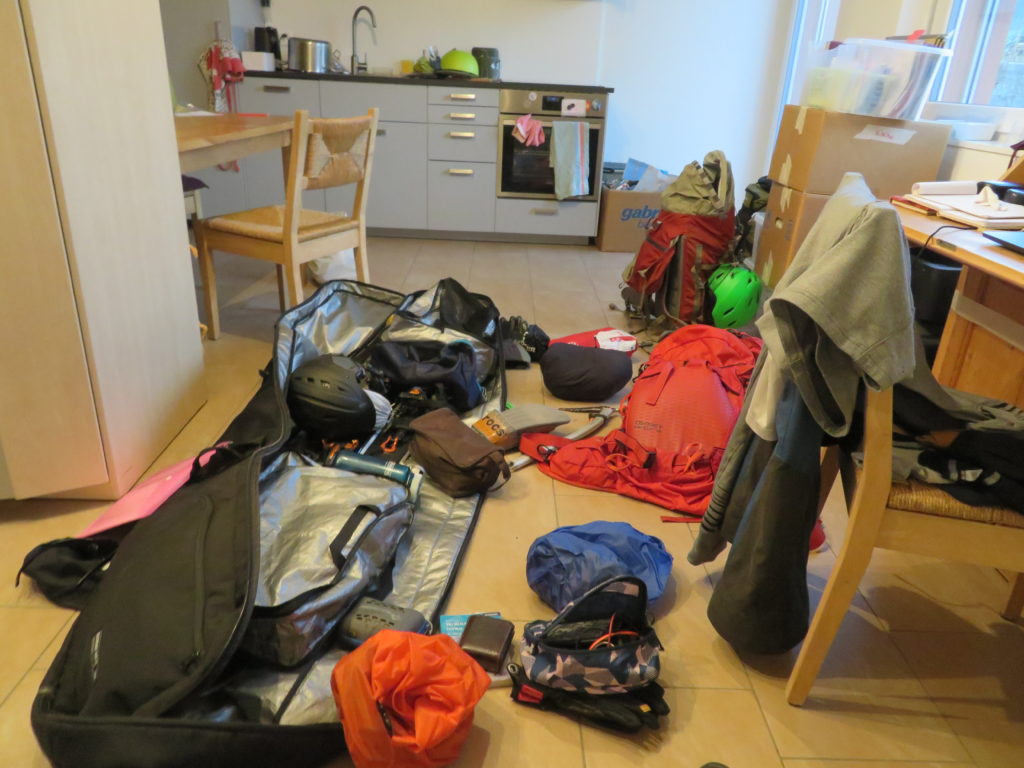
Reto and I had pre-booked 6 huts / hotels in the Albula Alps, where we had intended to spend a full week traversing the entire range from Bivio to Prazet. Such a long hut-to-hut journey is only possible in Europe, where the hut system is so well established that you aren’t required to carry much food, water, fuel, or even sleeping bags and camping gear. The huts usually have wardens who provide bedding, breakfast and dinner, and also will give you hot tea to fill your drink bottle for the day. So its really only necessary to carry your clothing system, water and snacks for the day, avalanche safety gear and other ski touring gear such as ski crampons, a harness, rope and ice axe depending on your objectives. All of this can be carried in a 45L ski touring pack. This is an absolute luxury compared to the heavy pack hauling necessary in New Zealand, where I learnt the basics of mountaineering.
Before Reto and I had even left Entlebuch, we started receiving calls from the hut wardens saying they could no longer accommodate us due to new social distancing regulations imposed by the Swiss government. It quickly became apparent that we were only going to be able to do day-tours from the valley. We booked new accommodation in hotels / Airbnbs that would enable us to get close to the areas that we had originally intended to ski. We spent two nights at Preda, one night at Madulain, and three nights at La Punt.
We were improvising, and I was constantly checking the news trying to make decisions about what to do about the remainder of my trip. Germany eventually closed its border – so I thought I might have to just spend the whole month in Switzerland. However, Australia soon issued a ban on all foreign travellers and a warning that all Australians should return home as soon as possible by their own means. With the threat of major airlines closing down, I shifted my return flight forward two weeks to Sunday March 22nd (originally it was April 2nd). Even with such an early departure, I think I was lucky to get home, with my return flight being one of the last to arrive in Brisbane before all other international flights were cancelled.
The irony of the situation was that despite the global crisis, in purely objective terms we had perfect local conditions to go ski touring in. The weather stabilised and was basically clear and sunny every day that week. The snow had consolidated with the freeze-thaw cycles and became low to moderate risk for avalanches, with the only real danger being that of wet slides in the heat of the afternoon. The crowds had disappeared because all the commercial ski resorts had closed, meaning we had next to zero chance of being exposed to COVID-19. Plus, there was more untracked snow to shred on our descents!
We did 6 excellent days of touring, ranging from 600m to 1300m of elevation gain per day. We nearly managed to cover the same amount of distance and elevation gain that we would have if we had been doing the full hut-to-hut tour originally planned, albeit with lighter packs and the benefit of a shower and proper bed at the end of each day.
Piz Laviner (3146m) from Hotel Preda
Our first objective was Piz Laviner from Hotel Preda. We didn’t quite get to the summit for need of ice axes and boot crampons which we didn’t take, however this was a big day with approximately 1300m of elevation gain through mostly moderately sloped alpine bowls and drainage channels. The descent was superb, with perfect untracked spring snow.


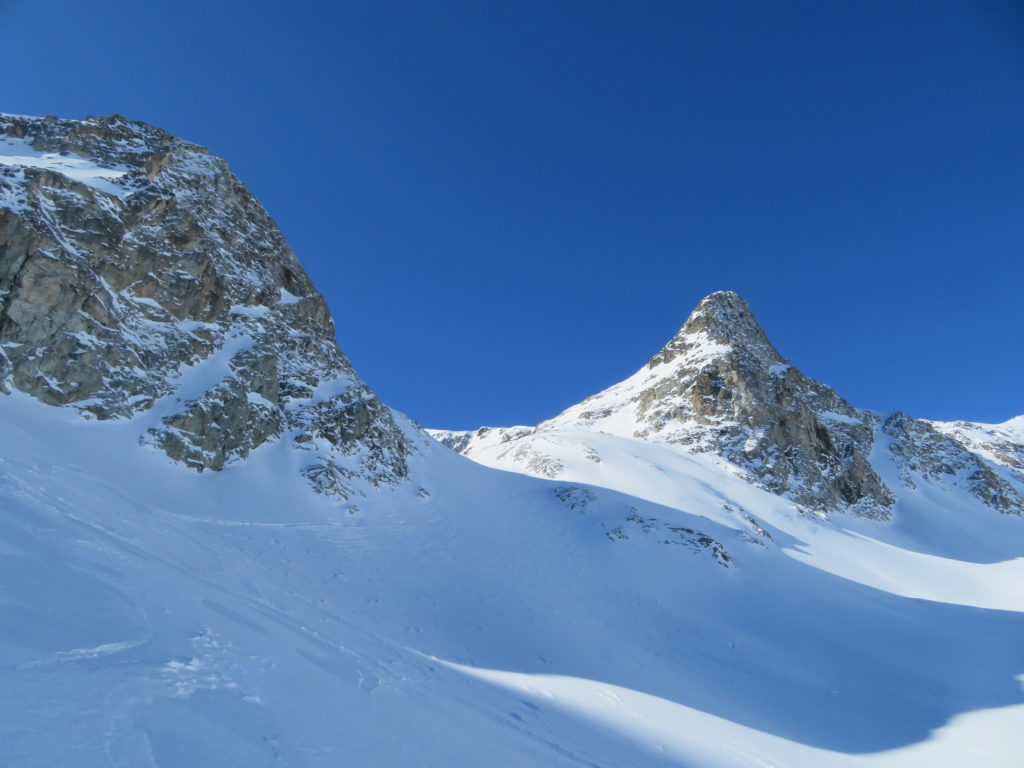


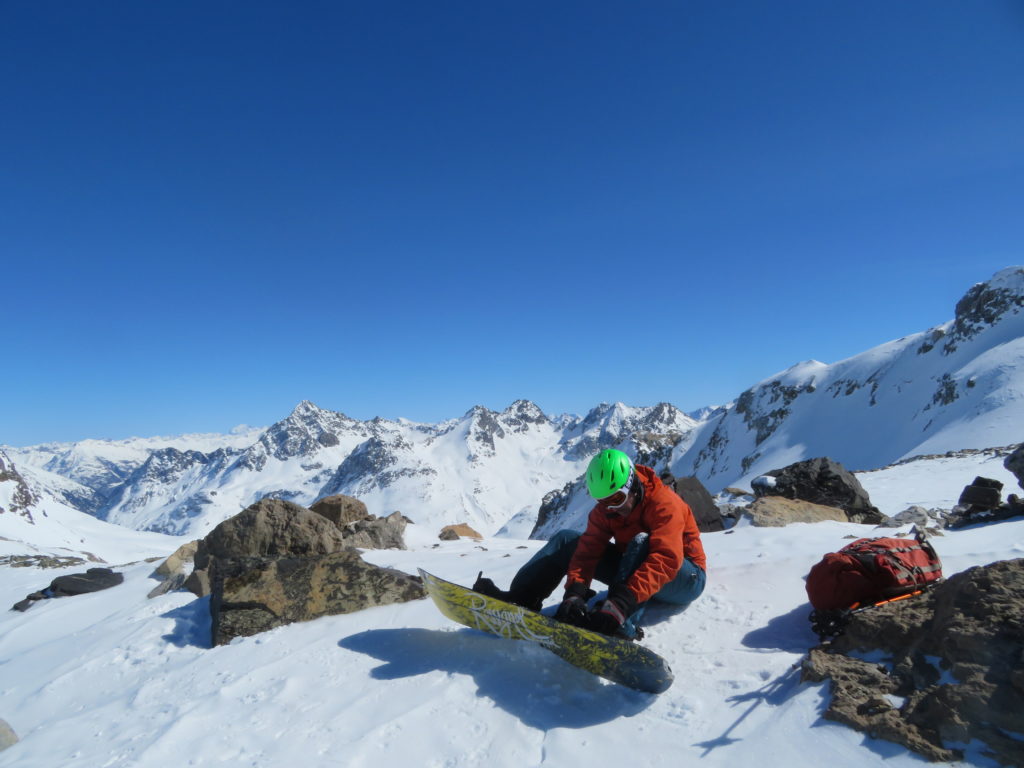
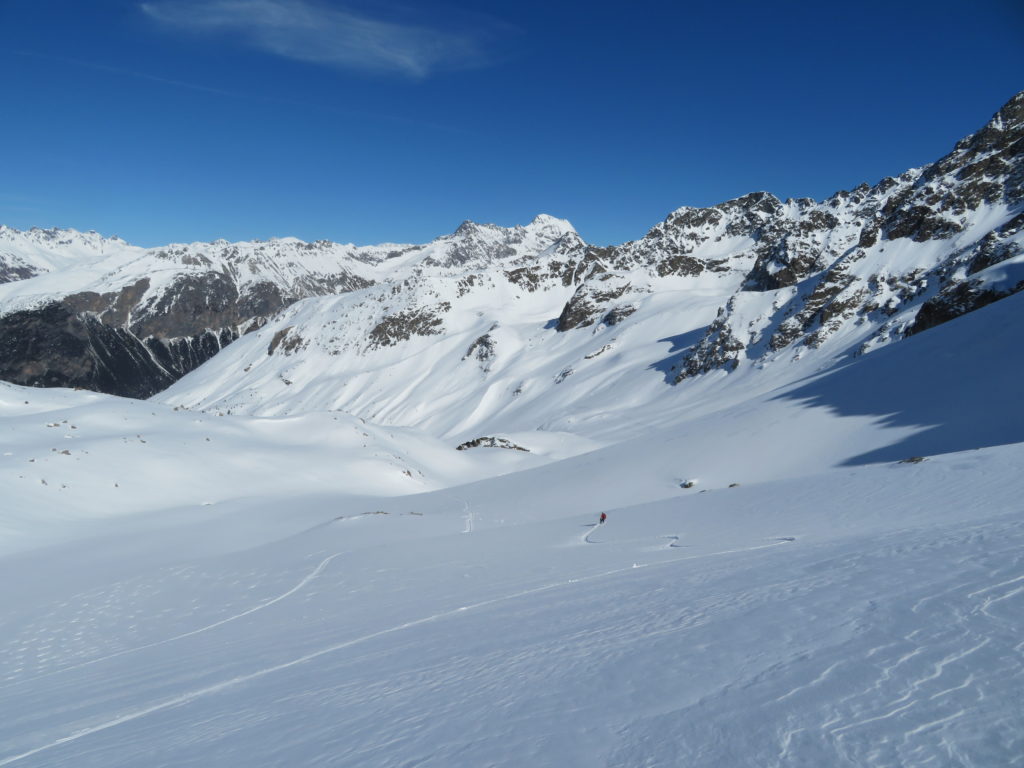
Peak 2672 near Fuorcola Dancler, from Hotel Preda.
This unnamed peak required approximately 800m of elevation gain, and allowed us to explore a different valley to the previous day. We enjoyed similarly spectacular conditions, albeit slightly icier snow on the descent.




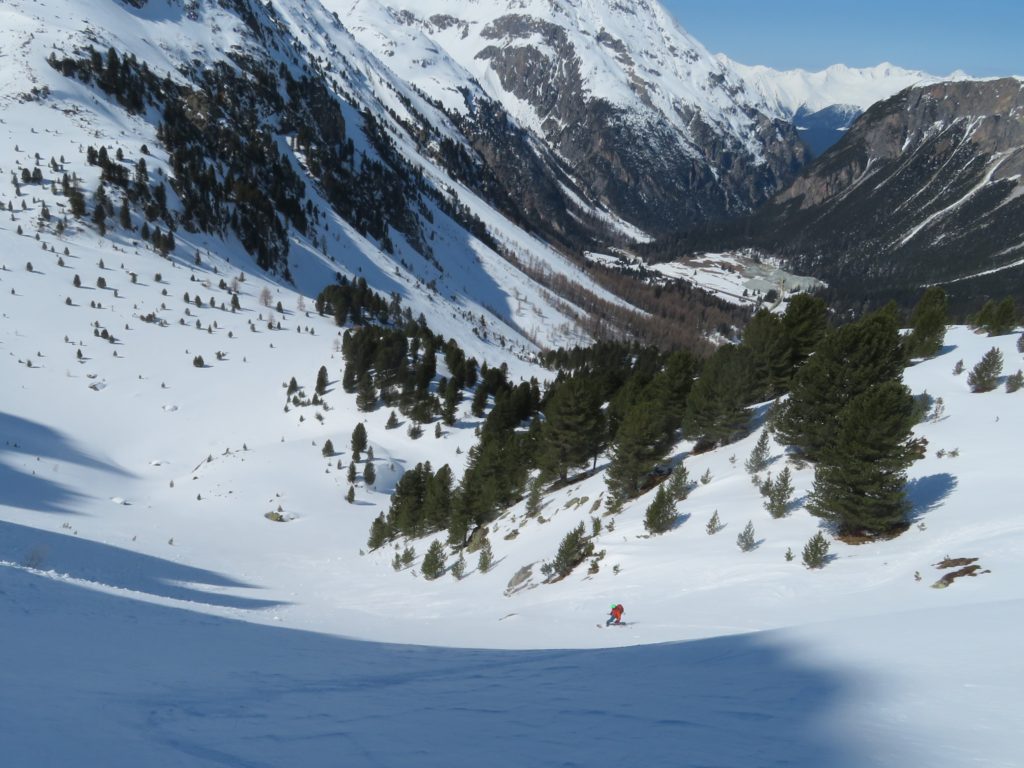
Piz Belvair (2821m) from Madulain
One of the huts we had originally intended to stay in was Chamanna d’Es-cha. This hut was accessible from the Engadine Valley from the village of Madulain. We skinned ~1100m up the gradually melting snow of the south face and ascended Piz Belvair adjacent the hut. We descended a gloriously slushy and open slope towards the ski-resort town of Zuoz, before catching a train back to our car we had left at Madulain. Again, we were essentially alone in the hills with superb spring skiing conditions. The COVID-19 crisis was easy to forget, until we got back into town and saw how deserted the place was.
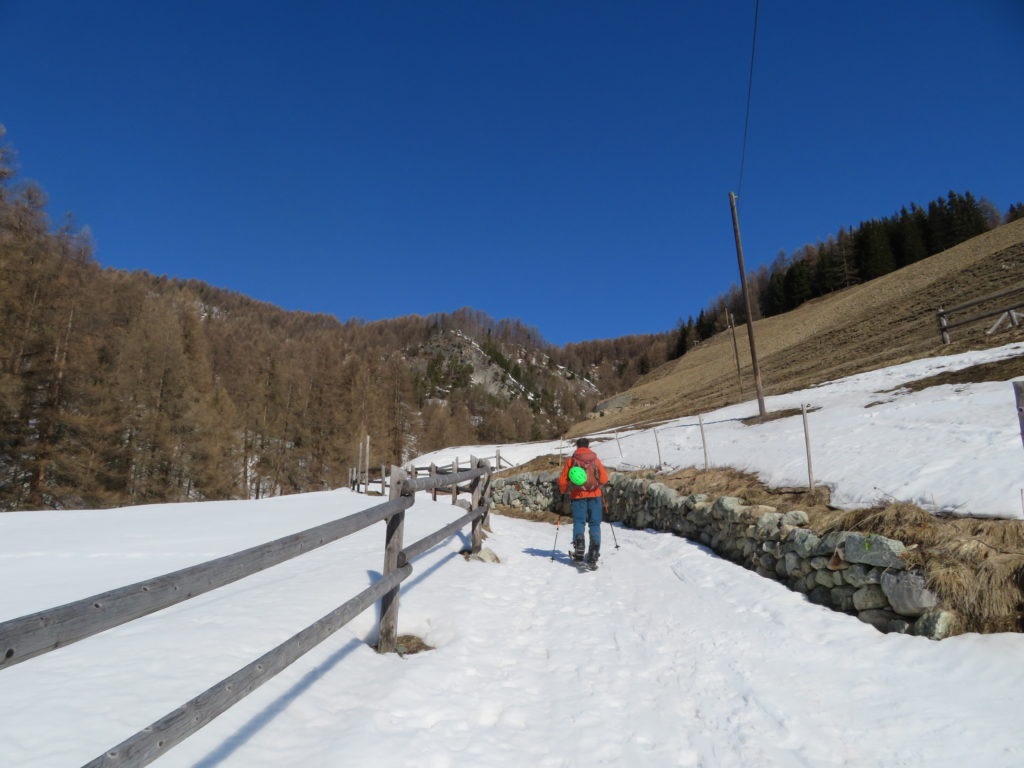
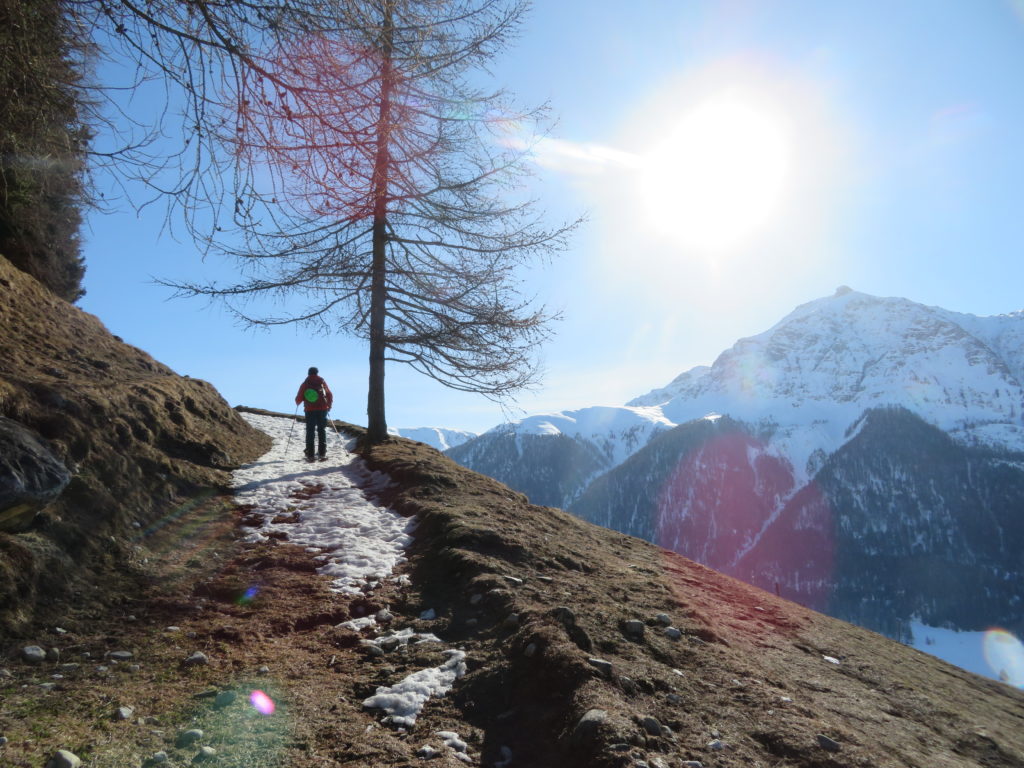


Munt Olivet (2917m) from Chamues-ch via Val Burdun
After a relatively cruisy ‘rest’ day ascending 600m towards an unnamed peak from the Albula Pass Road, our final big ascent was to Munt Olivet via Val Burdun and the Chamuera River. This was a big effort involving a complicated route with ~20km of skiing and ~1300m of elevation gain. The peak was significantly further away from any roads or ski resorts than anything we had previously done that week, and so had a genuinely wild feeling.
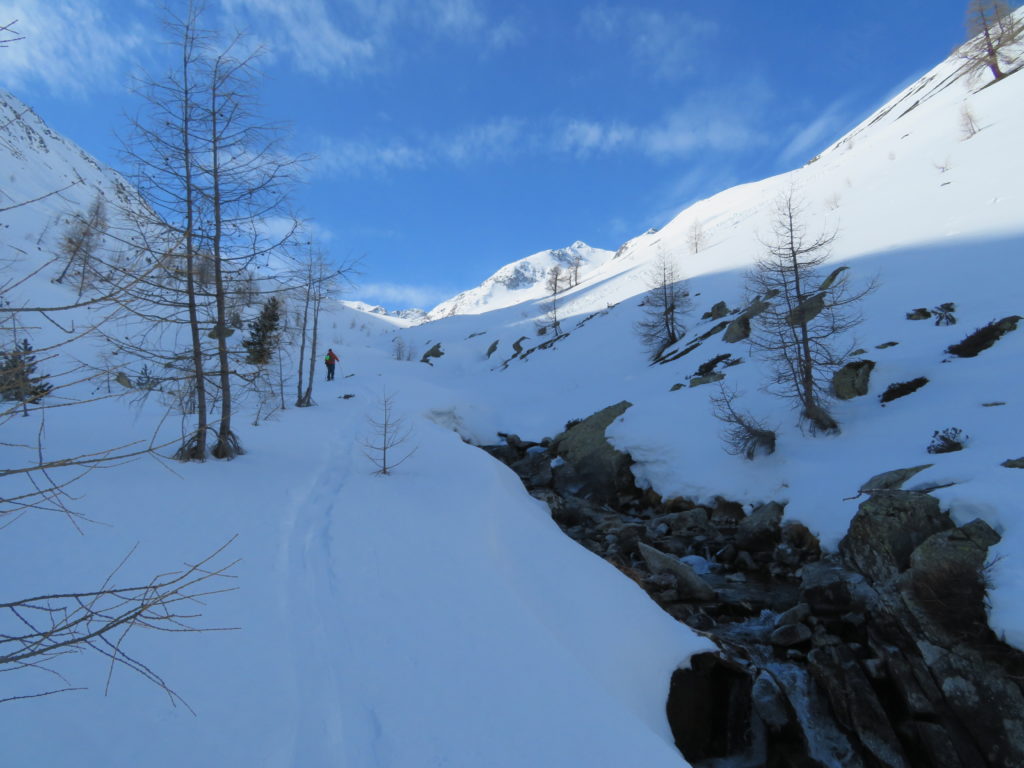
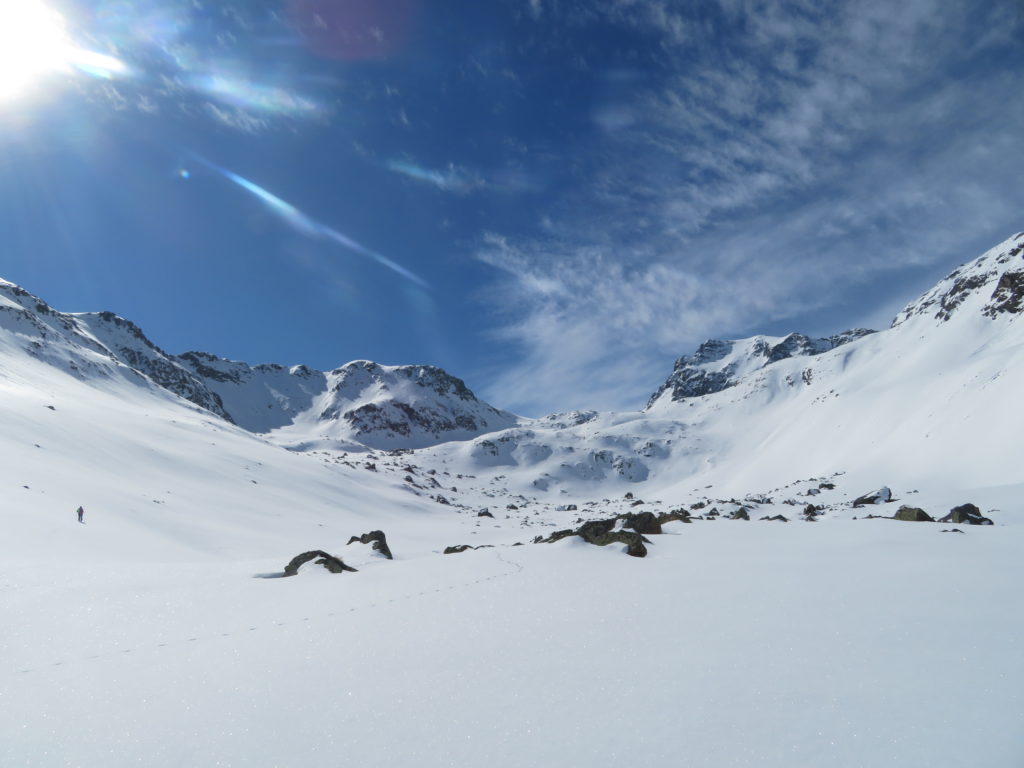

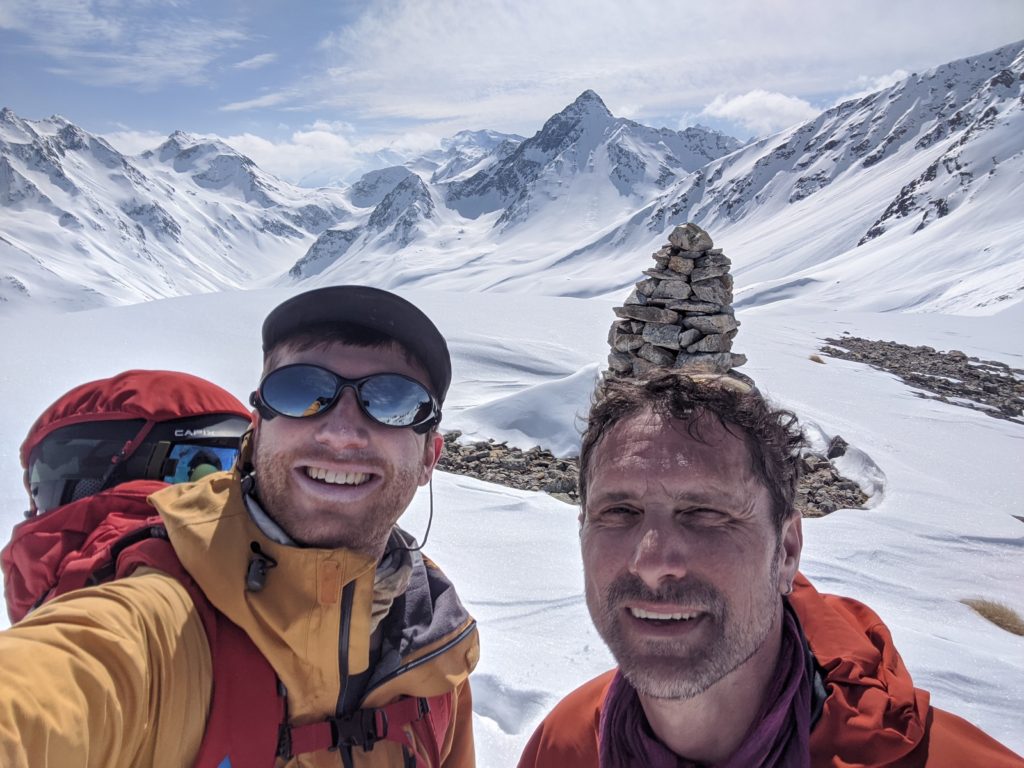

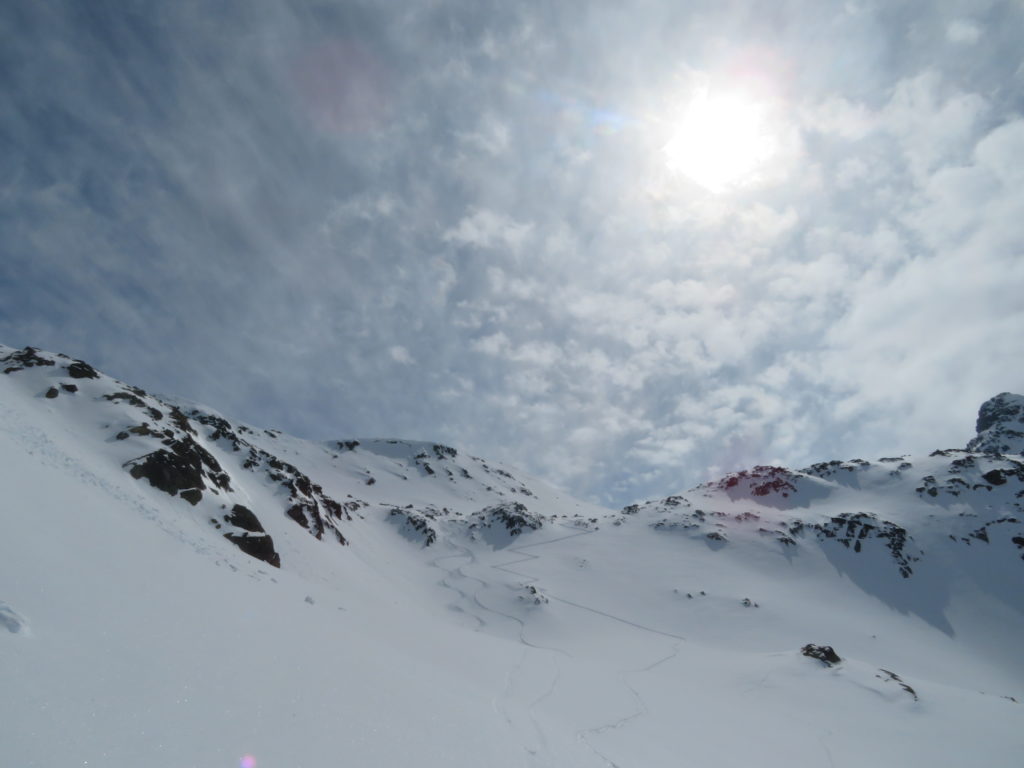
I was sad to have to cut short my long-planned Europe trip when the ski conditions were so good, but extremely grateful that I got home safely given the global pandemic. I had enough of a taste of alpine ski touring to confirm how much fun it is. With the backcountry kit and touring skis, one can continue skiing even when all the resorts are closed. Better yet, nearly every descent will be un-tracked, silent and completely yours. Descending so fast after many hours of hard uphill work almost feels like cheating, compared to standard mountaineering where one walks or abseils to get off the mountain. Now that I’ve experienced enough of this mode of travel through the mountains, I dare say it will be difficult to ever go back to resort skiing.
Best of luck to everyone in isolation for COVID-19. Stay safe!
